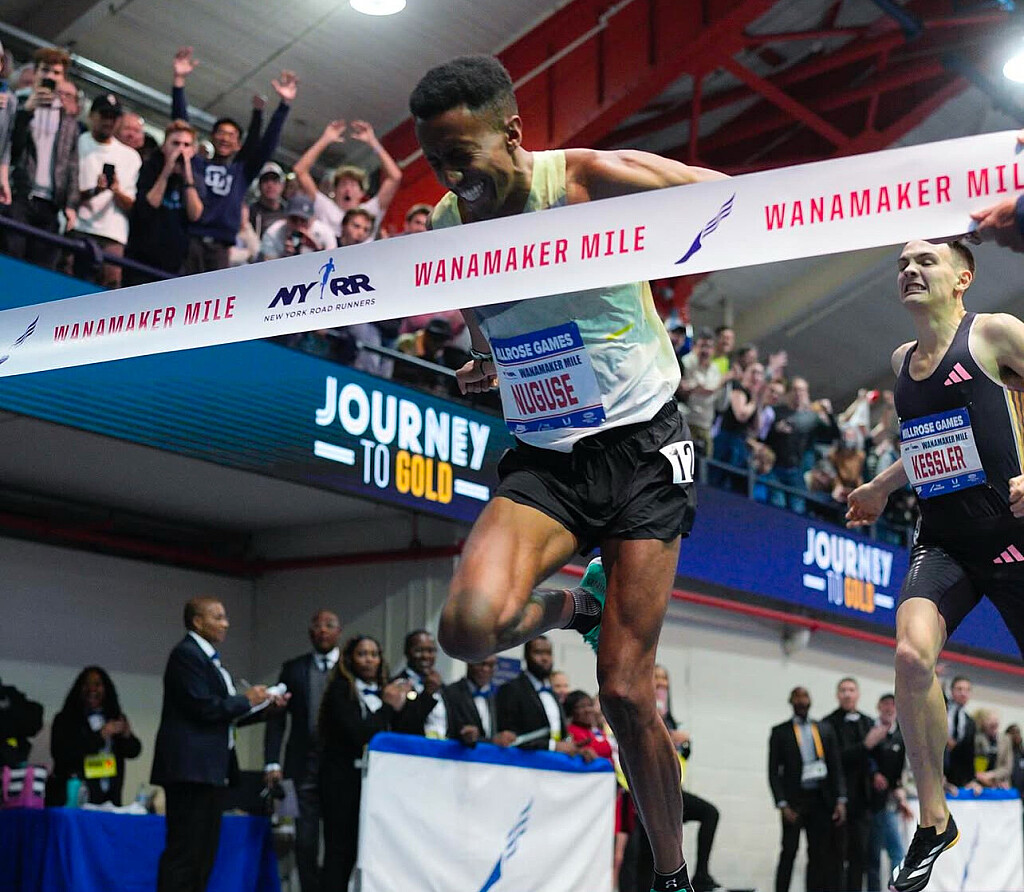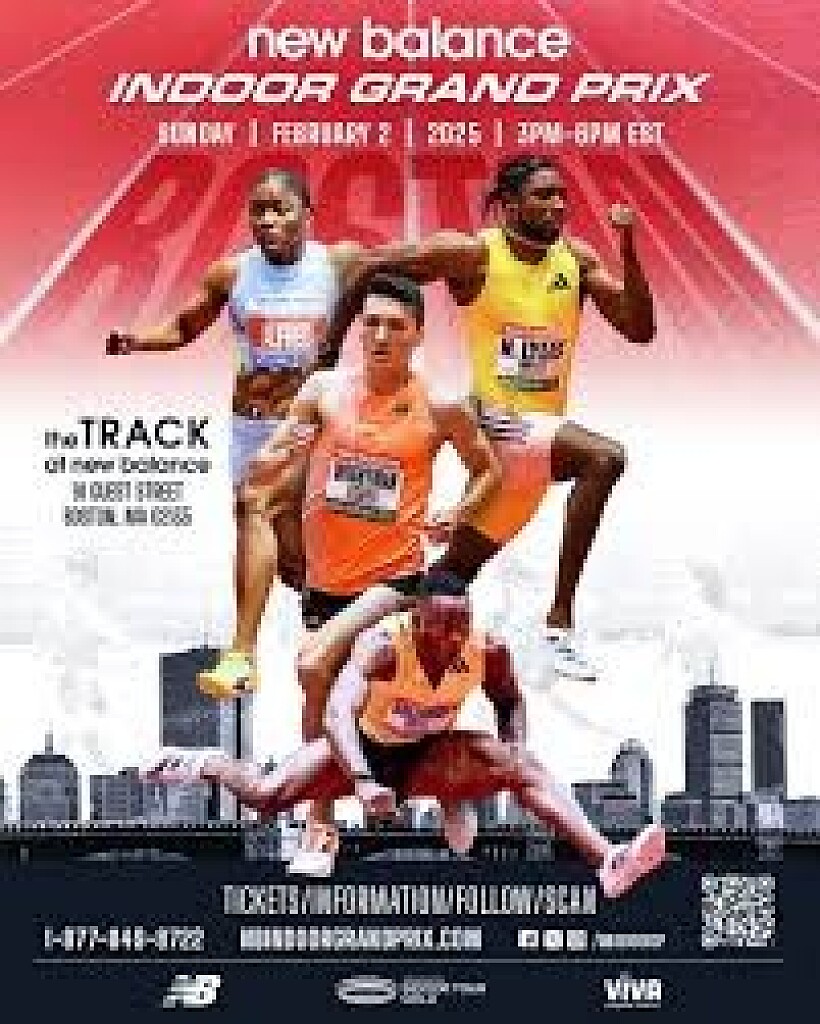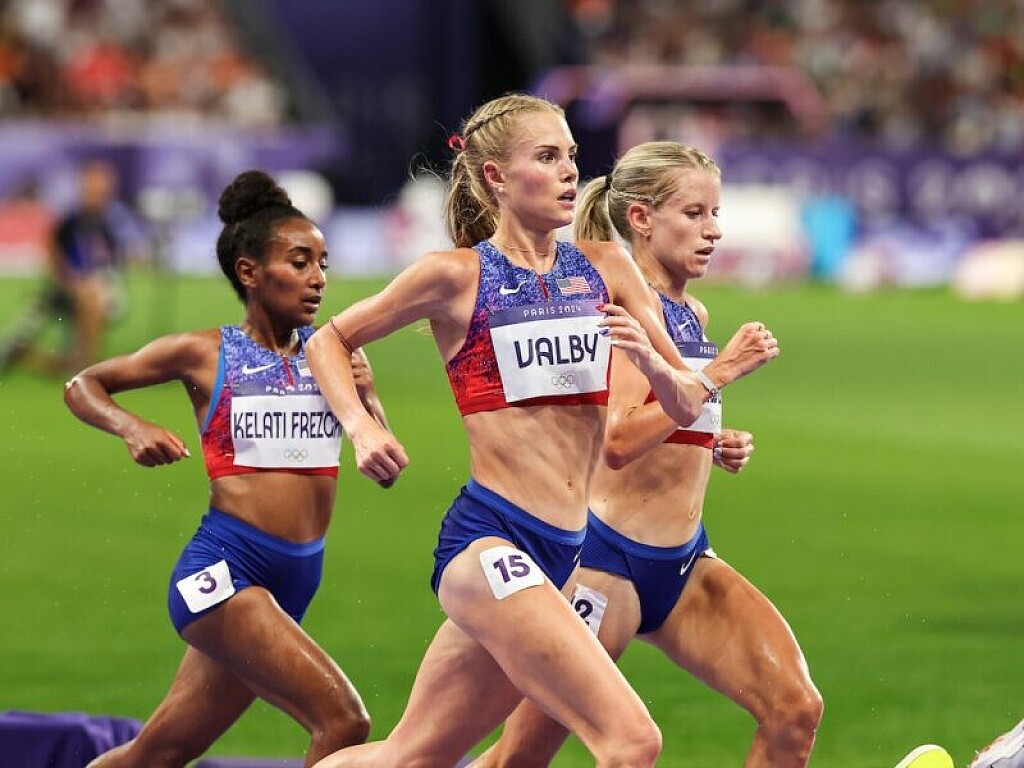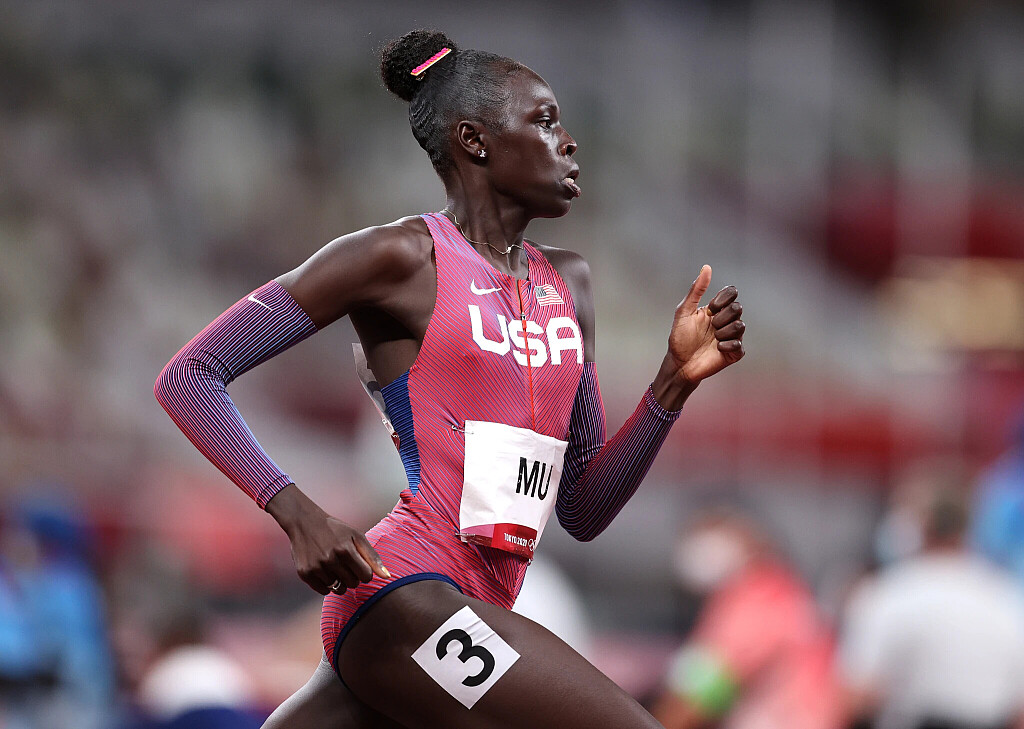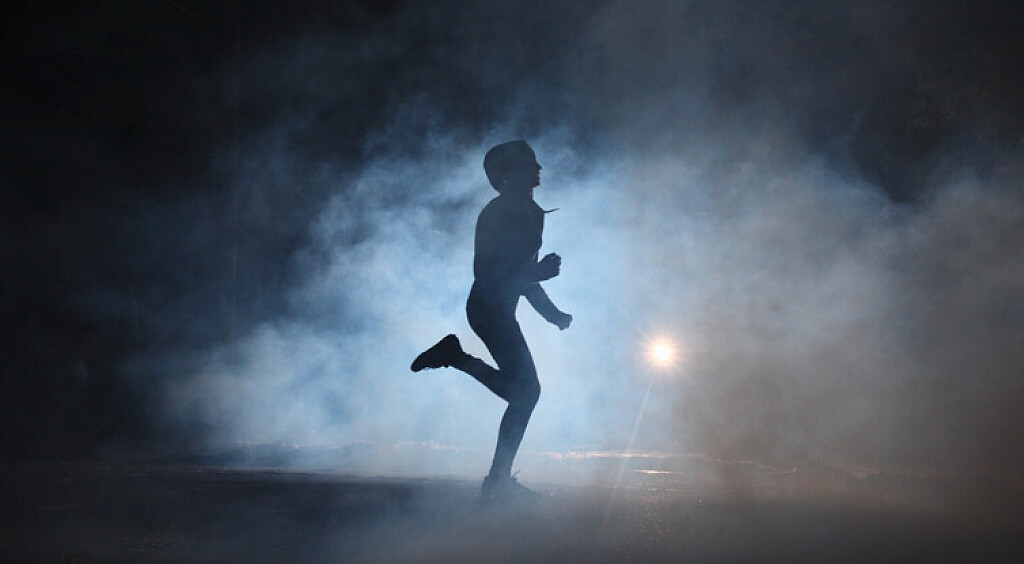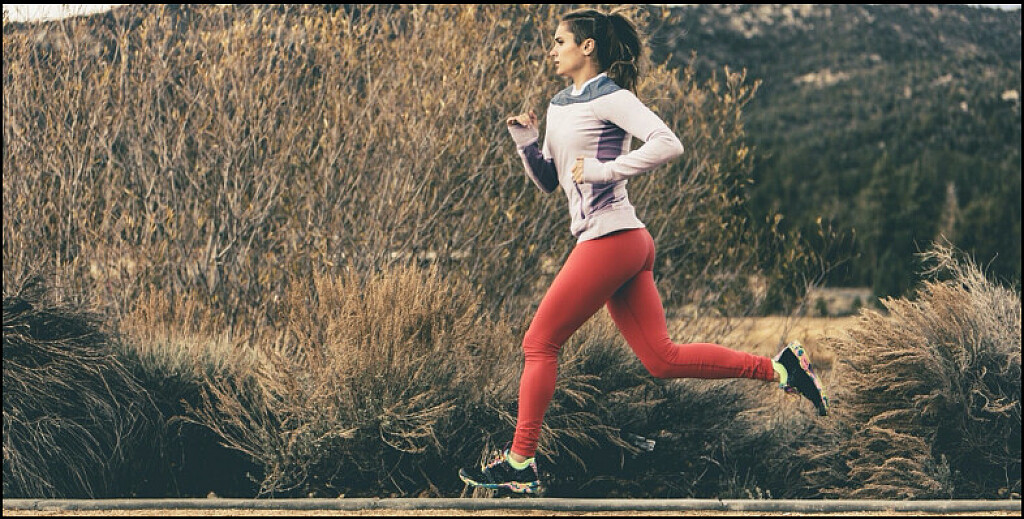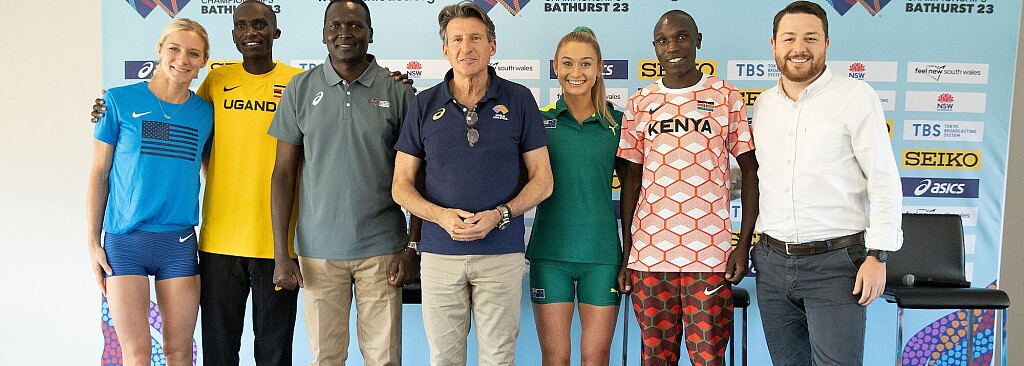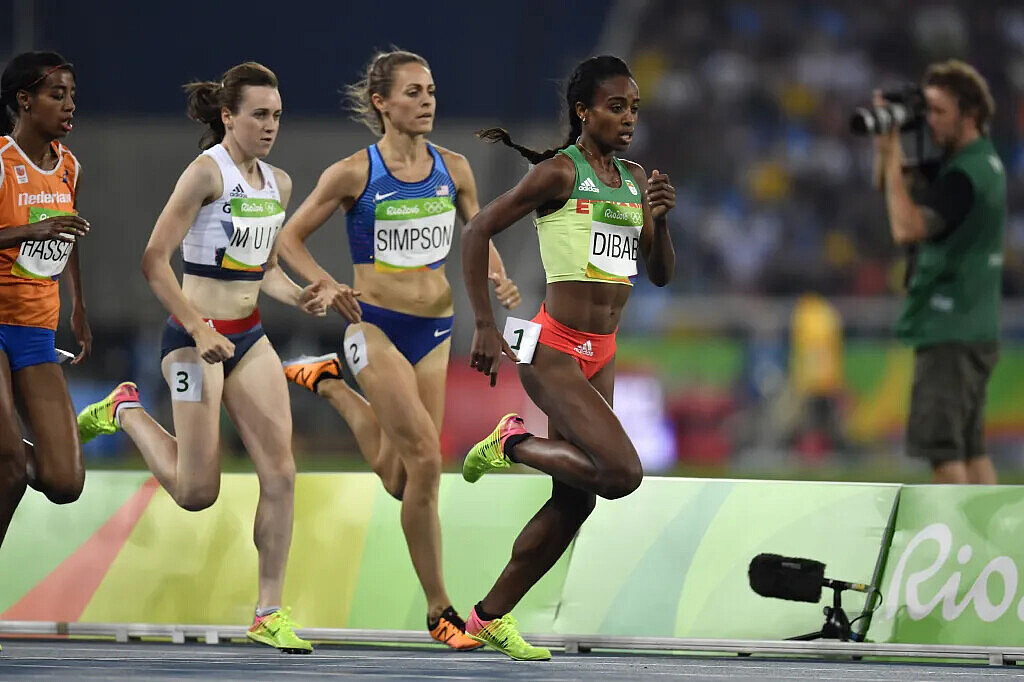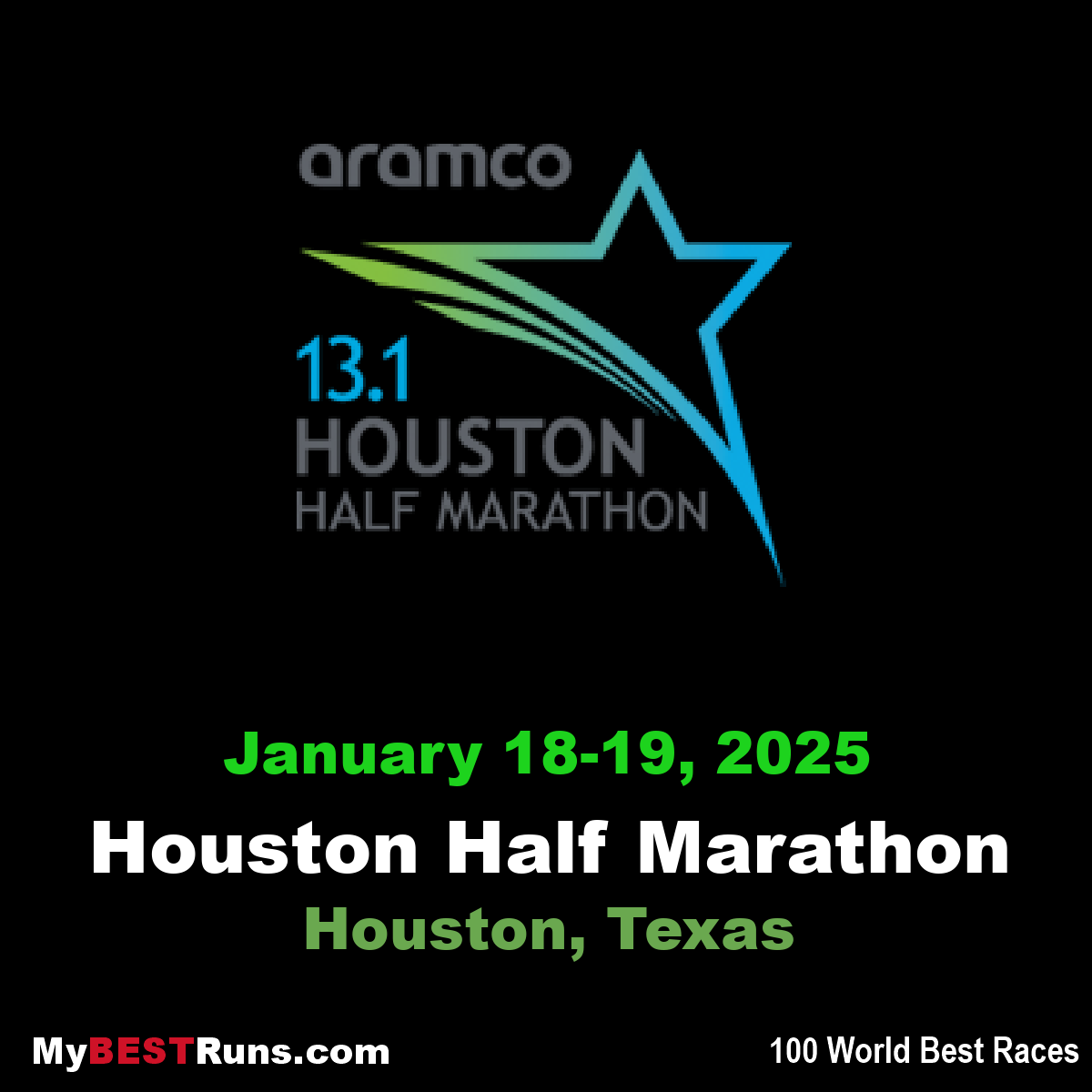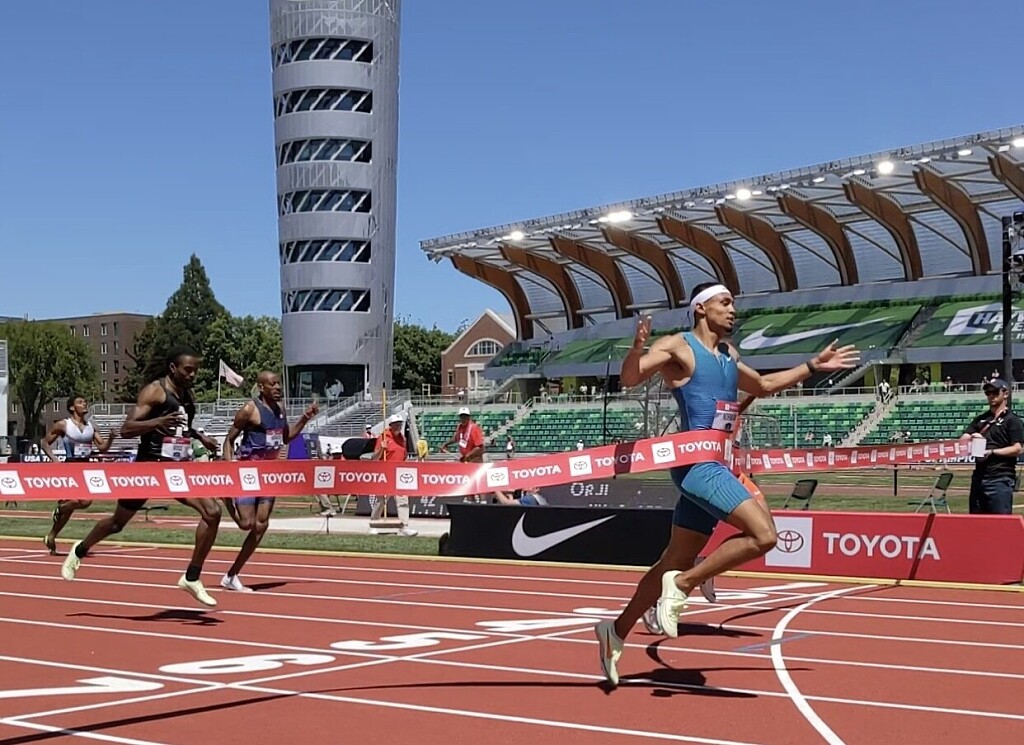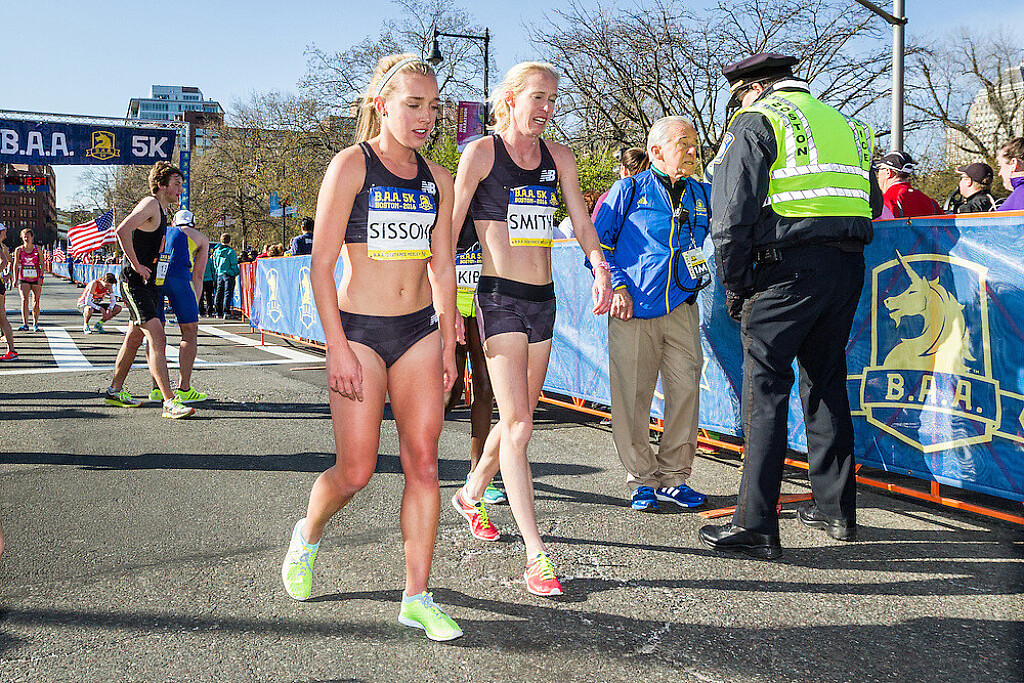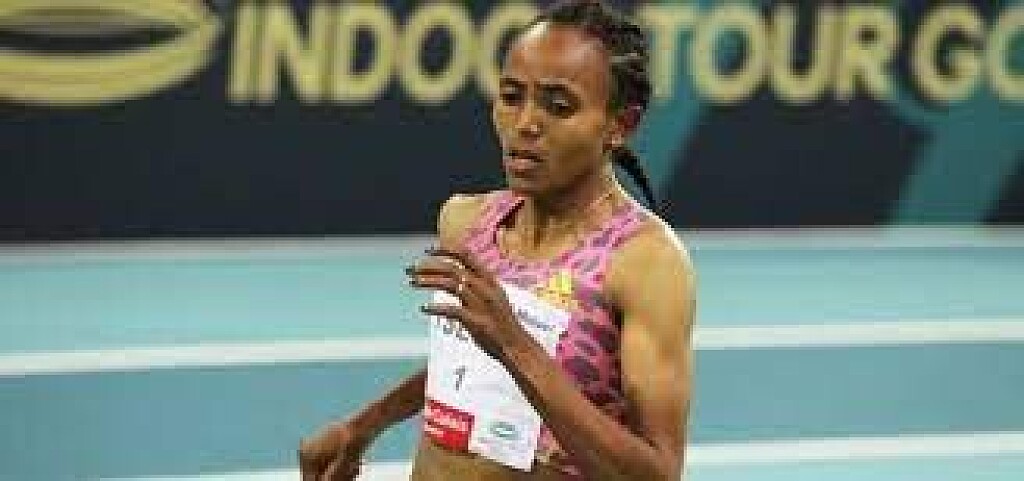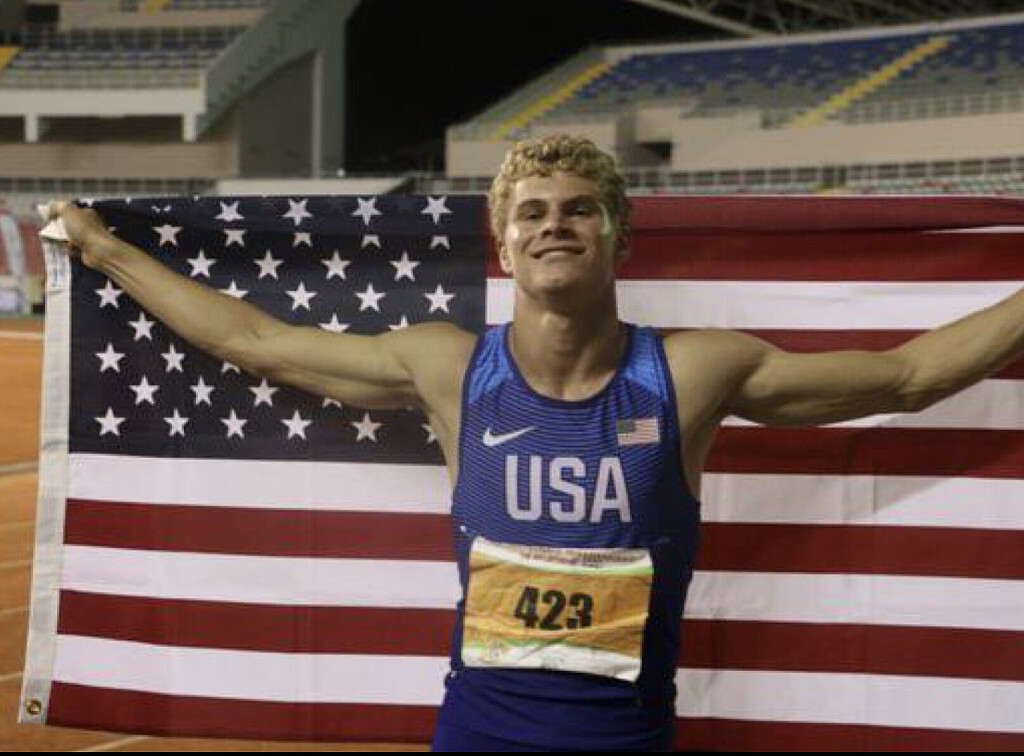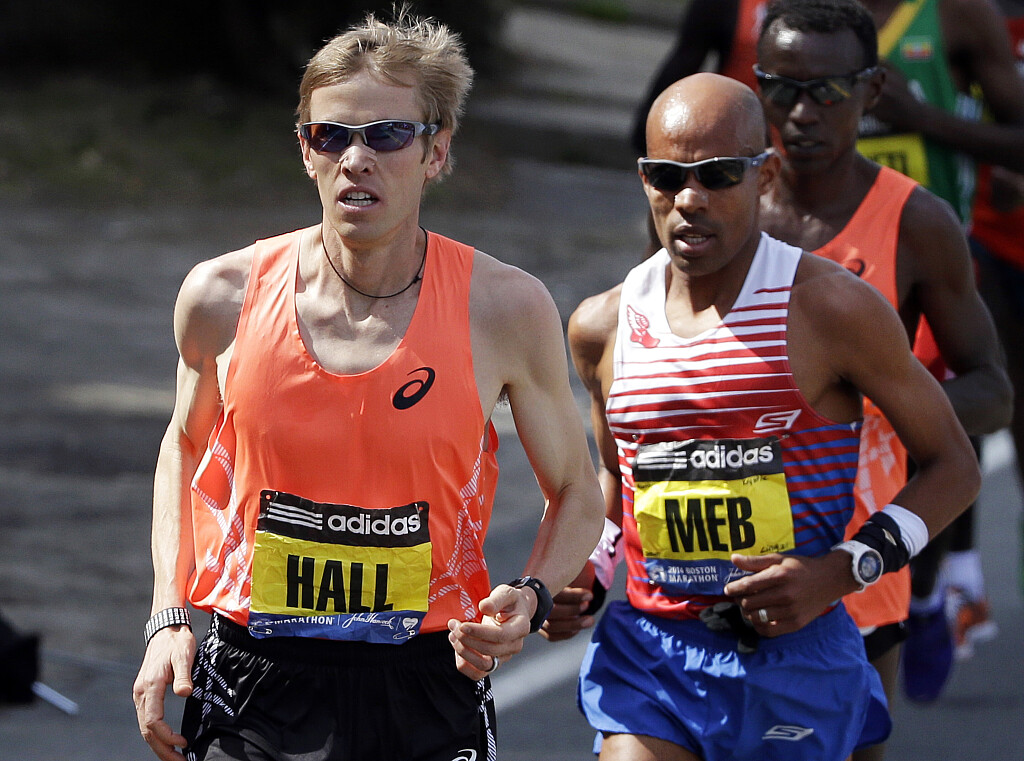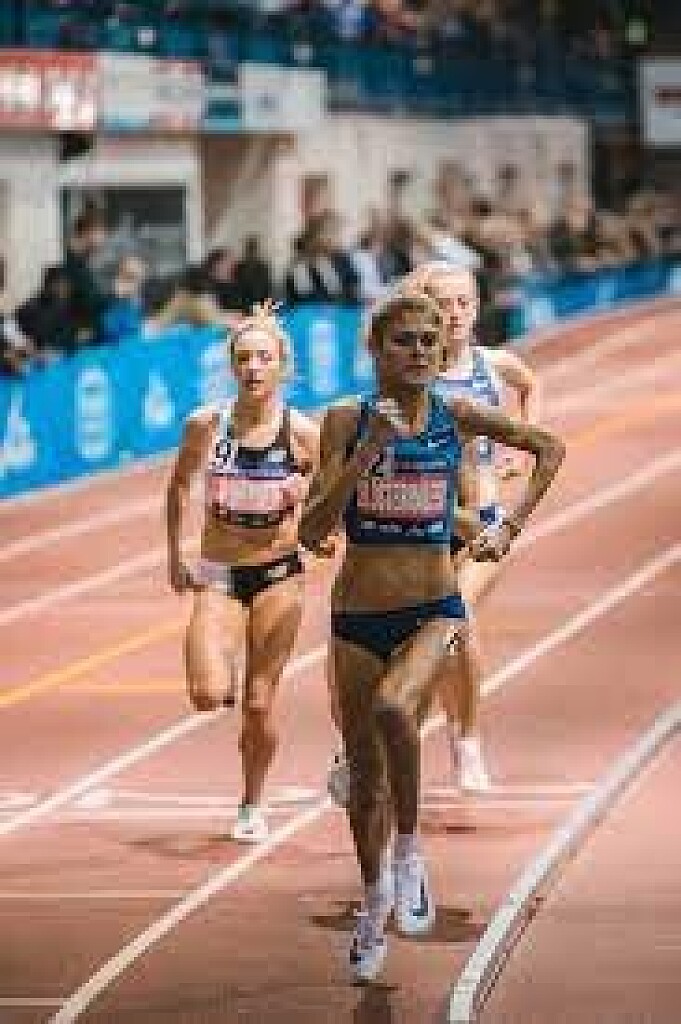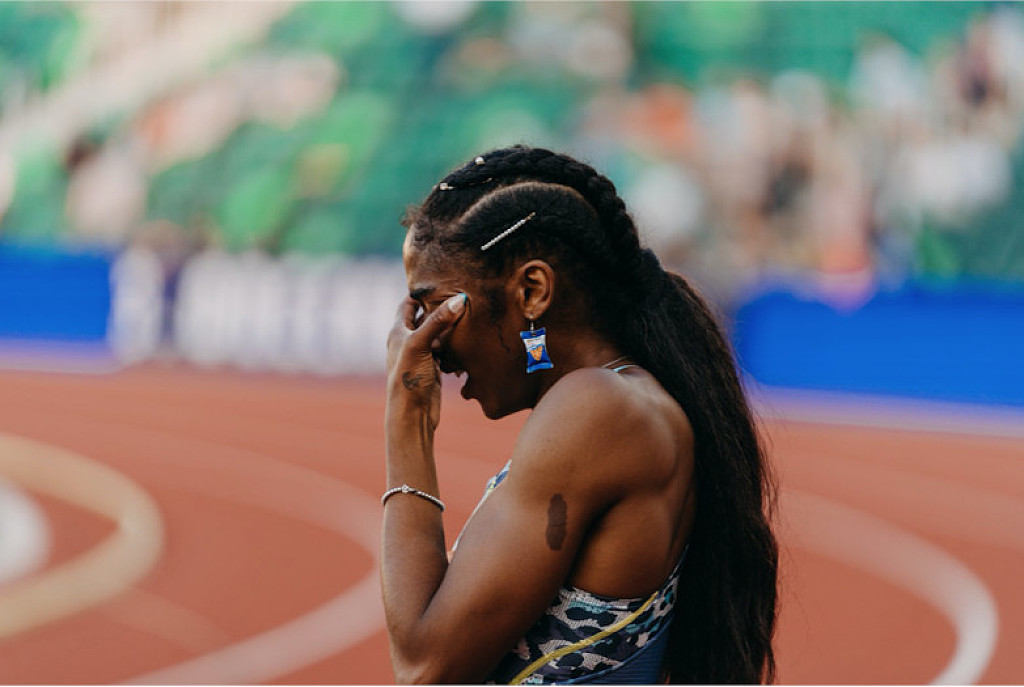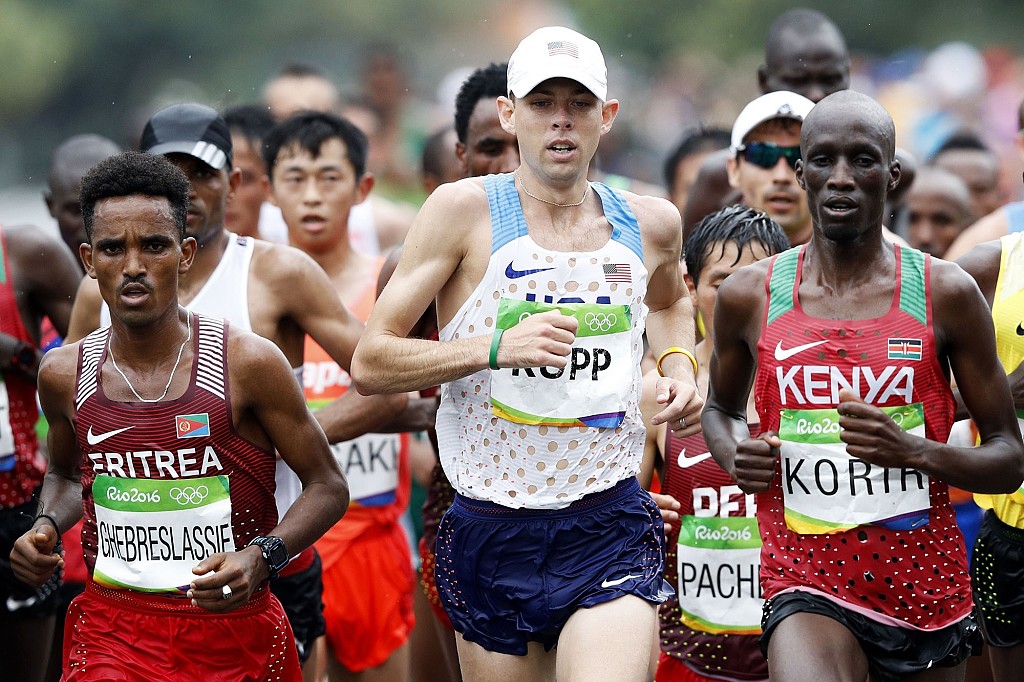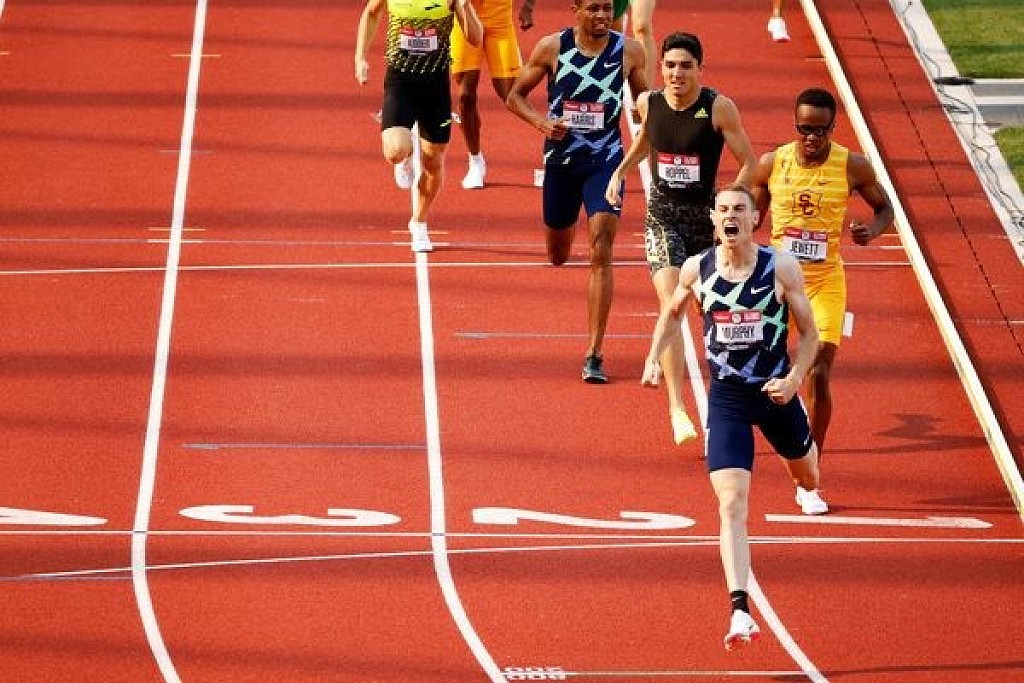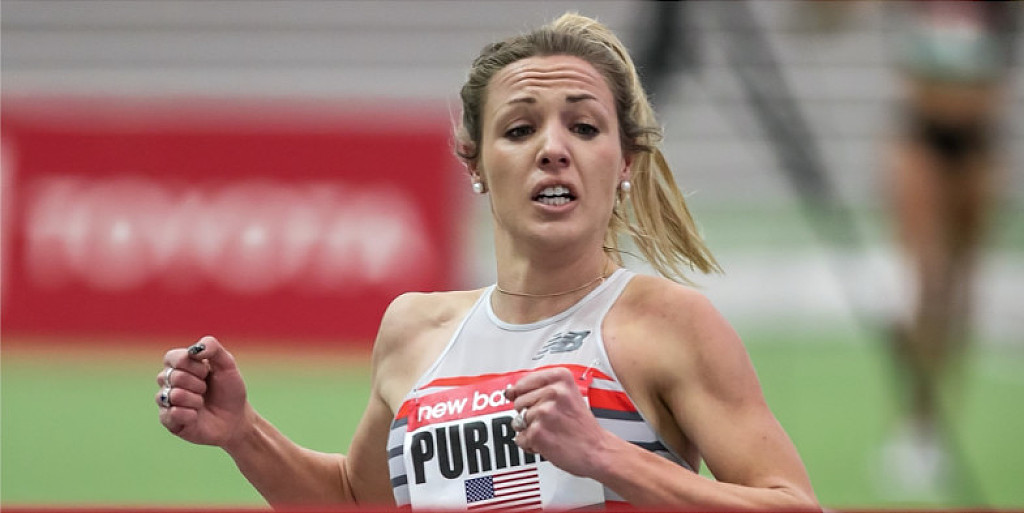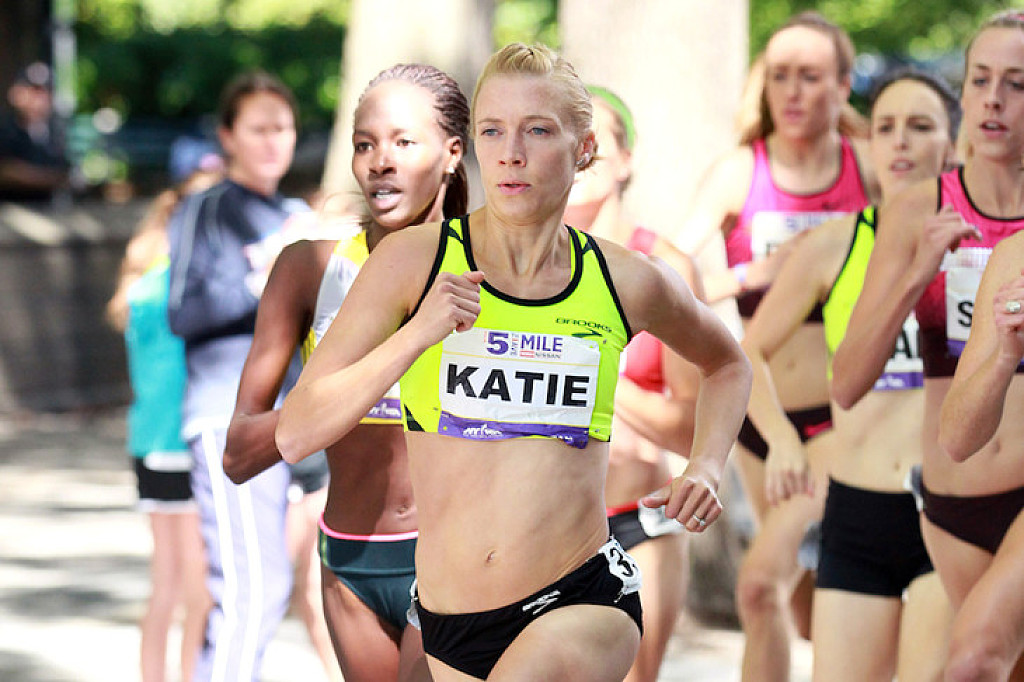Running News Daily
Running News Daily is edited by Bob Anderson. Send your news items to bob@mybestruns.com Advertising opportunities available. Train the Kenyan Way at KATA Kenya and Portugal owned and operated by Bob Anderson. Be sure to catch our movie A Long Run the movie KATA Running Camps and KATA Potato Farms - 31 now open in Kenya! https://kata.ke/
Index to Daily Posts · Sign Up For Updates · Run The World Feed
Articles tagged #Heather MacLean
Today's Running News
Historic World Records Dominate 2025 Millrose Games
The 117th Millrose Games, held on February 8, 2025, at New York’s Armory—a venue renowned as “The Fastest Track in the World”—delivered an unforgettable spectacle of middle-distance racing. Athletes shattered world records, national marks, and personal bests across events from the 800m to the 3000m, cementing this edition as one of the most electrifying in the meet’s storied history. Below, we break down the standout performances.
Records Fall in Mile, 3000m, and 800m
1. Wanamaker Mile: Yared Nuguse Rewrites History
Yared Nuguse (USA) stormed to a world indoor mile record of 3:46.63, eclipsing Ethiopian Yomif Kejelcha’s 2019 mark (3:47.01) . In a race missing world champion Josh Kerr (withdrawn due to illness), Nuguse led wire-to-wire, splitting 3:31.74 for 1500m—a North American record—before surging past a fierce challenge from Hobbs Kessler (3:46.90, also under the previous WR) . Australian teen Cam Myers stunned with a world U20 record of 3:47.48, while France’s Azeddine Habz (3:47.56) set a national record.
2. Men’s 3000m: Grant Fisher Outduels Olympic Champion
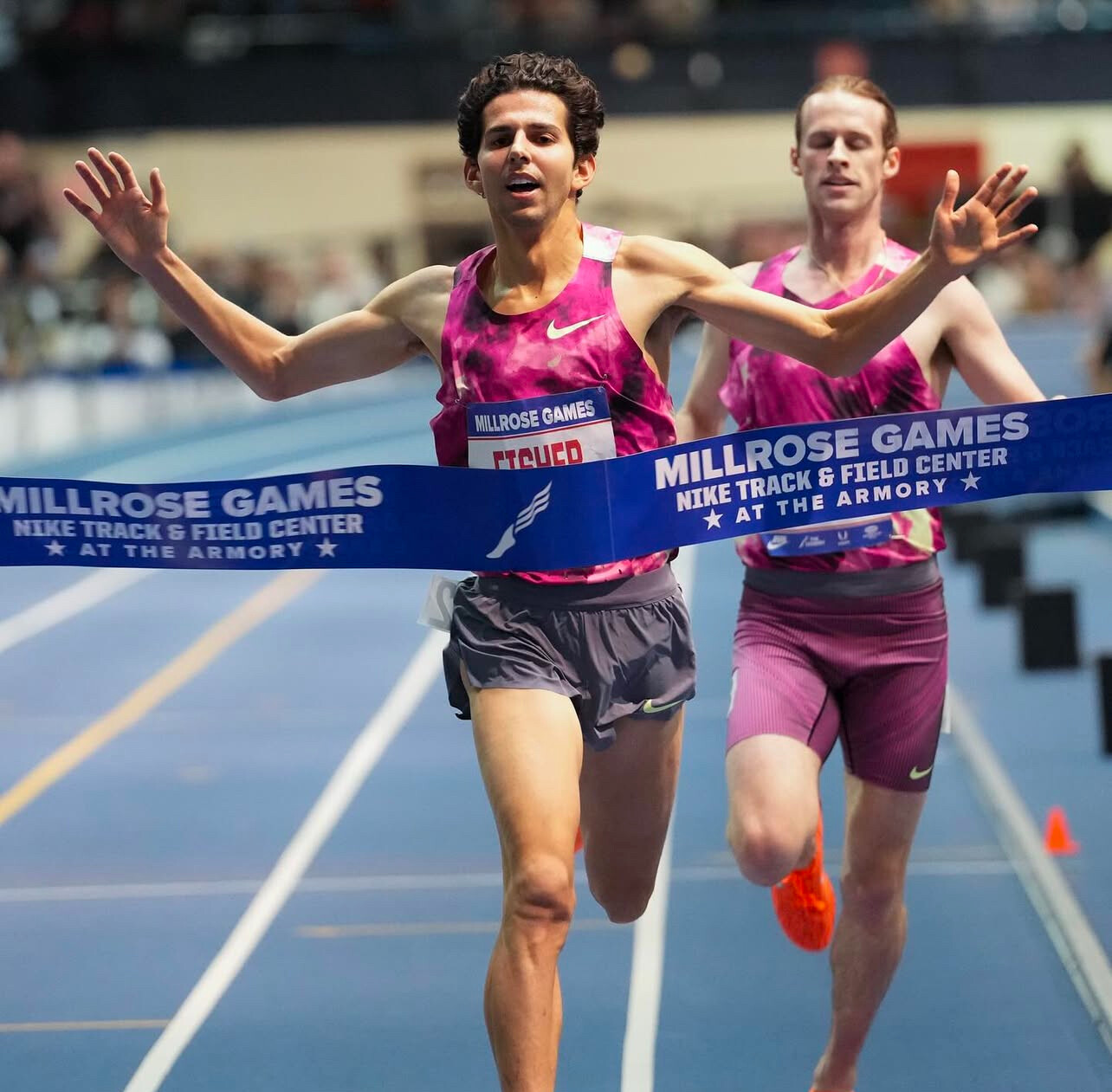
Grant Fisher (USA) and Cole Hocker (USA)—the Olympic 10,000m bronze medalist and 1500m gold medalist, respectively—collided in a tactical masterclass. Fisher’s 7:22.91 broke Lamecha Girma’s world indoor record (7:23.81), with Hocker (7:23.14) also surpassing the old mark . Fisher’s final 200m in 27.50 sealed the win, while France’s Jimmy Gressier (7:30.18) and Australia’s Ky Robinson (7:30.38) set national records .
3. Men’s 800m: Josh Hoey’s American Record Triumph
Josh Hoey (USA) dominated the 800m in 1:43.90, breaking Donovan Brazier’s American indoor record (1:44.21) and holding off Bryce Hoppel (1:44.19 PB) . Sixteen-year-old Cooper Lutkenhaus (1:46.86) smashed the high school record, previously held by Hoey himself .
Women’s Events: Breakthroughs in Mile, 3000m, and 800m

1. Women’s Wanamaker Mile: Georgia Bell’s Tactical Mastery
Georgia Bell (GBR), the Olympic 1500m bronze medalist, edged a stacked field to win in 4:23.35, outkicking Heather MacLean (USA, 4:23.41) and Nikki Hiltz (USA, 4:23.50) . Bell navigated a slow early pace (67.12 for the first quarter-mile) before unleashing a 61.97 final lap, crediting her composure in a “hard and messy” race .
2. Women’s 3000m: Whittni Morgan’s Commanding Victory
Whittni Morgan (USA) surged late to win in 8:28.03, a personal best, ahead of Josette Andrews (USA, 8:29.77) and Sarah Healy (IRL, 8:30.79 NR) . Ethiopia’s Tsigie Gebreselama (8:33.13) and Australia’s Jessica Hull (8:30.91) added depth to a fiercely competitive race .
3. Women’s 800m: Shafiqua Maloney’s Dominance
Shafiqua Maloney (VIN) claimed victory in 1:59.07, fending off a late charge by Addy Wiley (USA, 2:00.14) . Olivia Baker (USA, 2:00.02 PB) and Kaela Edwards (USA, 2:00.14) rounded out the podium in a race showcasing tactical grit .
With world records in the mile (Nuguse) and 3000m (Fisher), plus a slew of national and age-group marks, the 2025 Millrose Games underscored the rising global standard in middle-distance running. As athletes shift focus to outdoor seasons, these performances set the stage for a thrilling 2025 World Championships.
by Boris Baron
Login to leave a comment
NYRR Millrose Games
The Pinnacle of Indoor Track & Field The NYRR Millrose Games, first held in 1908, remains the premier indoor track and field competition in the United States. The 2025 edition will once again bring the world’s top professional, collegiate, and high school athletes to New York City for a day of thrilling competition. Hosted at the New Balance Track &...
more...Sprint Showdowns and Distance Battles to Take Center Stage at the New Balance Indoor Grand Prix
The New Balance Indoor Grand Prix, a World Athletics Indoor Tour Gold meeting, is set to deliver thrilling track action in Boston on Sunday (Feb 2), with an elite lineup of global gold medalists ready to ignite the indoor season. The competition will serve as a crucial stepping stone towards the World Athletics Indoor Championships Nanjing 25 in March.
Sprints and Hurdles: Lyles and Alfred Lead the Charge
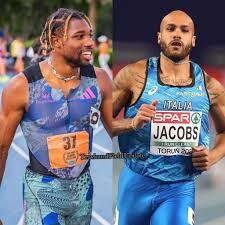
Olympic and world sprint sensation Noah Lyles returns to defend his 60m title, after setting a meeting record of 6.44 last year. Lyles, who claimed 100m gold and 200m bronze at the Olympics, kicked off his season with a 6.62 win in Gainesville last weekend. He will face Trayvon Bromell (USA), Zharnel Hughes (GBR), and 2022 world indoor champion Marcell Jacobs (ITA), who is making his North American indoor debut.
In the women’s 300m, Olympic 100m champion Julien Alfred steps up in distance for her New Balance Indoor Grand Prix debut. After winning world indoor 60m gold in Glasgow, Alfred took 100m gold and 200m silver at the Olympics and ended last season with a Diamond League Final victory. She faces a competitive field including 2019 world 200m champion Dina Asher-Smith (GBR) and USA’s Lynna Irby-Jackson.
The men’s 300m features Olympic 400m hurdles gold medalist Rai Benjamin. A past winner in Boston, Benjamin is set to battle 4x400m relay star Vernon Norwood and Matthew Boling.
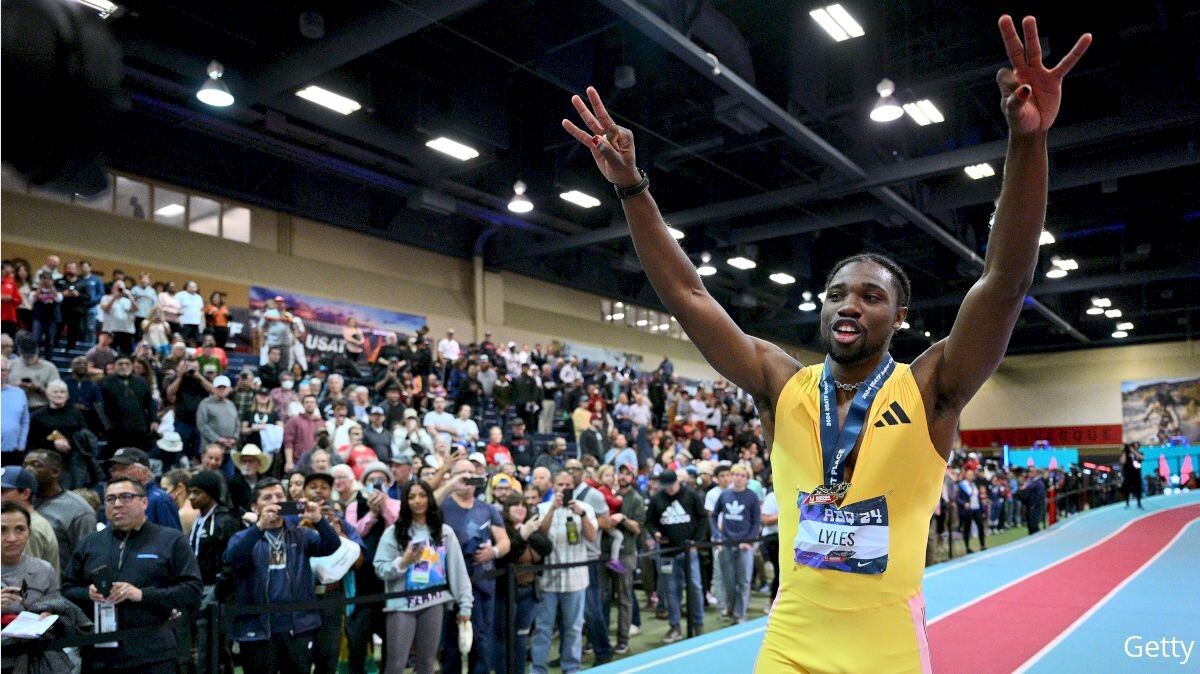
The 60m hurdles events promise fireworks, with world record-holder Devynne Charlton (7.65) and Olympic champion Masai Russell renewing their rivalry. Russell edged Charlton in their recent clash in Lubbock, but the Bahamian sprinter leads their head-to-head series 8-2. Joining them are Olympic finalists Ackera Nugent, Grace Stark, and 2018 world indoor silver medallist Christina Clemons.
For the men, world record-holder Grant Holloway (7.27) looks to extend his 10-year unbeaten streak in the 60m hurdles. The Olympic and world champion headlines the field alongside Olympic finalist Freddie Crittenden and 2022 world silver medallist Trey Cunningham.
Middle and Long Distance Races: Olympic Medalists Face Off
The women’s 3000m sees Olympic 1500m silver medalist Jessica Hull (AUS) take on Great Britain’s Olympic bronze medalist Georgia Bell. Hull, the defending champion, set an Oceanian indoor record of 8:24.93 in this event last year. They are joined by USA’s Parker Valby, Emily Mackay, Elise Cranny, Ethiopia’s Melknat Wudu, Italy’s Sintayehu Vissa, and Olympic steeplechase medalist Emma Coburn.
In the men’s 1500m, USA’s Grant Fisher (Olympic 5000m and 10,000m bronze medalist) takes on 2022 world champion Jake Wightman (GBR), Oliver Hoare (AUS), and Josh Hoey, who recently broke the North American 1000m record.
Bryce Hoppel, the reigning world indoor 800m champion, leads the men’s 800m field, while Hobbs Kessler, Cameron Myers, Neil Gourley, and Andrew Coscoran battle in the 3000m.
Other Key Events
Women’s 60m: Mikiah Brisco (USA) and Zoe Hobbs (NZL) lead the field.
Men’s 400m: 2022 world indoor champion Jereem Richards (TTO) races USA’s Quincy Wilson.
Women’s 500m: Dutch 4x400m Olympic champion Lisanne de Witte takes on USA’s Olympic 800m medallist Raevyn Rogers.
Women’s Mile: Heather MacLean (2023 winner) faces Olympic finalist Susan Ejore, Maia Ramsden, and Sage Hurta-Klecker.
With an electrifying lineup of Olympic and world champions, the New Balance Indoor Grand Prix promises high-stakes racing and a preview of the talent heading to Nanjing 25.
by Boris Baron
Login to leave a comment
Pro runner’s next-level workout on the road to L.A. Olympic medal
The newest member of team New Balance Boston, Parker Valby, has settled into her Boston life with her fellow Olympian training partners and coach Mark Coogan. After setting NCAA records in the outdoor 5,000m and 10,000m, the former Florida Gator began her professional running career as a New Balance athlete. A video posted by FloTrack on Wednesday dove into a soft-surface November workout during the base-building season in the lead-up to the indoor track season–which Valby demolished.
“Most people don’t know Parker as a person,” Coogan said. “They just see her as a runner. She’s a wonderful young lady and she’s fitting in great.” The 22-year-old announced her surprise signing with New Balance in October, unexpectedly straying from Nike after becoming their first female track and field athlete to sign a Name, Image, Likeness (NIL) deal. Industry sources report that Valby’s contract is upwards of USD 700,000 and will be in play until well past the 2028 L.A. Olympic Games.
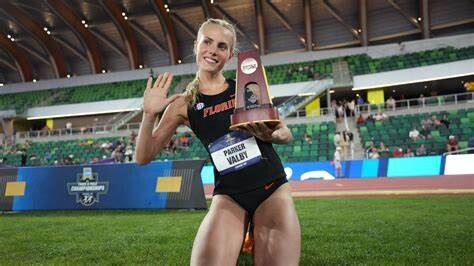
“It was definitely a learning experience,” Valby said about her time at the Paris Olympics. “It was my first time racing outside the NCAA. I’m very grateful for the experience and the lessons I took from it–it wasn’t my ideal performance that I wanted, but I’m happy that I did it in hindsight, so I can be ready for L.A.”
“Parker said she wants to get a medal at the Olympics in L.A.,” Coogan added. “She’s gonna make us better, and hopefully we can make her better and she can do big things in the future.”
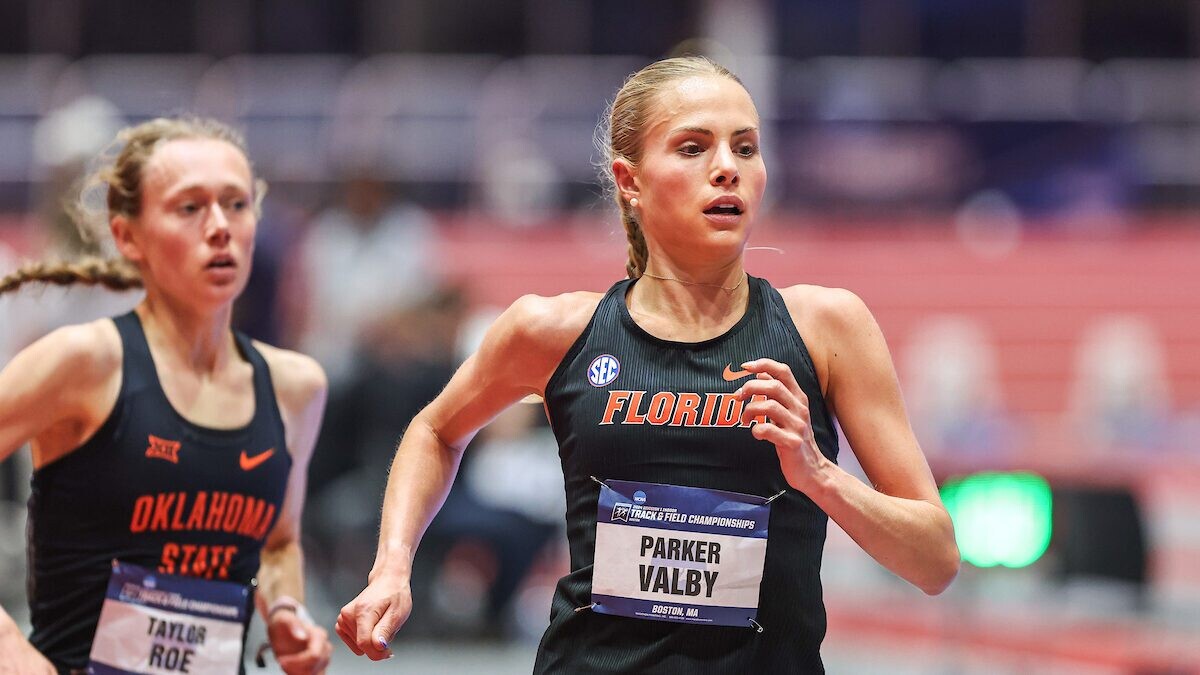
The workout path was roughly 1,000m, though Coogan admitted he wasn’t sure of the exact distance. The coach was aiming for the team to have a solid workout where the athletes could stick together. The target effort for the cross-country-style workout was to begin at threshold pace (comfortably hard). Other pro athletes at the practice include Paris Olympian Emily Mackay, 2020 Olympian Heather MacLean, and Coogan’s daughter, Katrina Coogan.
The workout: 3 x (2K, 2 minutes, 1K)
Set 1: 2 loops: 6:38, 1 loop: 3:06
Set 2: 2 loops: 6:20, 1 loop: 3:02
Set 3: 2 loops: 6:01, 1 loop: 2:50
The video shows Valby sharing the lead with her teammates before pulling away from the group during the final set. An extra 1K loop was added on, which Valby completed in 2:53.
Although Valby is younger and less experienced than her teammates, Coogan says she’s a bit stronger than the other women because she comes from a 10,000m background. The other athletes’ main events are 1,500m and 5,000m.
“We work together, we meet in the middle,” Valby said. “Train with others to make yourself better.”
According to MacLean, the team has tried to create a culture of respect and support. “[Parker] brings a fresh new perspective to everything,” she said. “I learned something from her, I hope she learned something from us.”
“Almost like a college cross-country team, we’ve made a team into a family, and I think that’s one of the reasons we’re so successful,” Coogan said. His Instagram revealed that the team hit the indoor track for the first time last week. If all the athletes stay healthy, the whole New Balance Boston team will open their season at the New Balance Grand Prix on Feb. 2.
by Cameron Ormond
Login to leave a comment
LA 2028 Summer Olympics Games
Discover how the Los Angeles Candidature Committee describes their vision for the Games and the legacy they plan to leave behind: For centuries, people have been following the sun to California – to a coastal paradise of beautiful weather, inspiring landscapes and an ocean of possibilities. Since it was first settled, LA – the City of Angels – has built...
more...The Olympic and world 800m champion Athing Mu will make her season debut at the USATF NYC Grand Prix Meet on June 24
Athing Mu, the Olympic and world 800m champion, will make her season debut at the USATF NYC Grand Prix. This meet is part of the World Athletics Continental Tour Gold series, the USATF NYC Grand Prix takes place at Icahn Stadium on Randall’s Island June 24.
It will be Mu's first competition in exactly 11 months, as she returns to action for the first time since the World Athletics Championships Oregon22, where she added world 800m gold to the Olympic title she claimed in Tokyo.
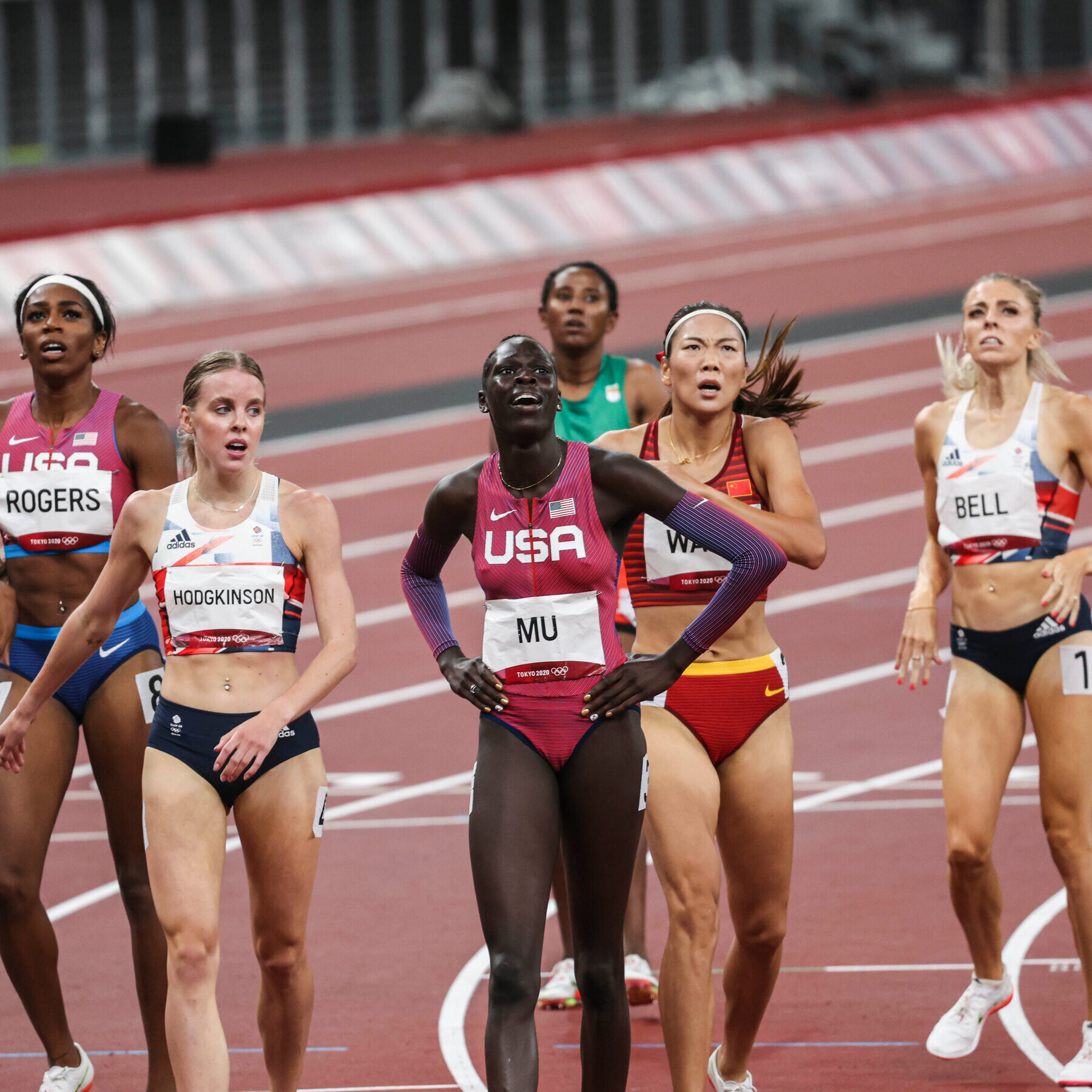
Mu made herself known as one of the world’s top track athletes in 2021 when she won the NCAA title in the 400m, and then gold medals in the 800m and 4x400m relay at the Olympic Games. The 21-year-old followed up her Olympic success with gold in the 800m in Oregon, running 1:56.30. Her US record of 1:55.04 was set in Eugene in August 2021.
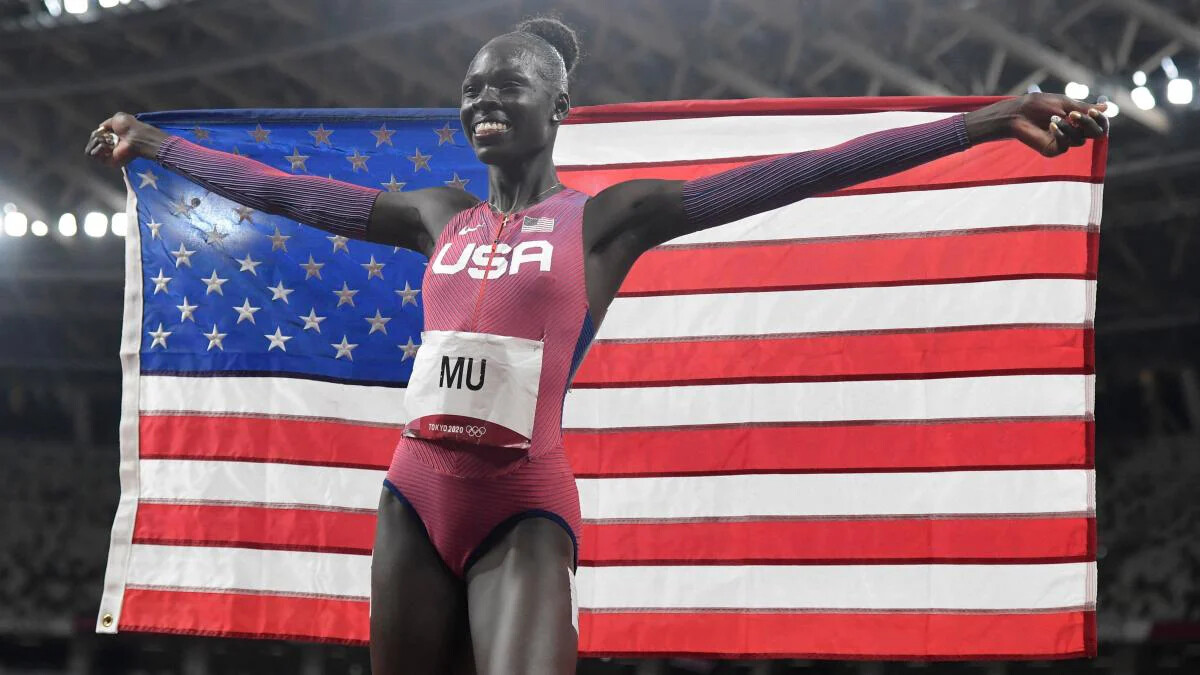
Athing Mu was born and raised in Trenton, New Jersey, and is the second youngest of seven siblings. Her parents immigrated to the United States from South Sudan, and her family is of South Sudanese heritage. She began competing in track at the age of 6. Mu did not join her high school track team, choosing to compete instead for Trenton Track Club. She graduated from Trenton Central High School in 2020
Challenging her in New York will be her fellow New Jersey native and the world indoor 800m champion Ajee’ Wilson, and the US indoor 1500m champion Heather MacLean.
In the women’s 100m hurdles, 2015 world champion Danielle Williams of Jamaica joins a field that includes Keni Harrison of the United States, the former world record-holder, and Jamaica’s Megan Tapper, the Olympic bronze medallist.
Those top athletes join the previously-announced Noah Lyles, Gabby Thomas, Zharnel Hughes, Ackeem Blake, Sydney McLaughlin-Levrone, Aleia Hobbs, Melissa Jefferson, Devon Allen, Trey Cunningham, Robert Dunning, Bryce Hoppel, Will Sumner, Chase Ealey and Maggie Ewen.
by World Athletics
Login to leave a comment
How to Achieve Your Running Goals? Become an Aerobic Monster.
OlympYou’re a busy person who wants to optimize every minute of training to achieve your goals.
I can help you. I’ve coached Olympians, national- and world-record holders, and national and NCAA champions. Each reached the pinnacle of the sport by making the most of the miles they ran while avoiding injury and burnout. To do that, you need to understand the demands racing requires of your body and train effectively to adapt your body to meet those demands.
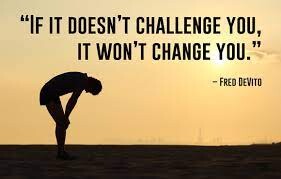
The races that most runners train for are almost entirely aerobic events. Yes, even the mile or the 5K. To succeed at those distances, you need to be able to sustain a hard pace for several minutes, and often for more than an hour.
You need to be an aerobic monster.
I like to explain this idea by talking about a common race goal. Many of the women I coached collegiately wanted to break 5:00 in the mile. I would ask: “Can you run 75 seconds for one lap of the track? Of course you can, pretty easily. How about 2:30 for two laps? Yes, but it’s starting to get hard. How about 3:45 for three laps? Now that’s getting really hard. Could you then run a fourth lap in less than 75 seconds? Almost certainly not right now.”My point was that a short segment at your desired race pace isn’t a big deal. (If it is, you probably need a less ambitious goal.) If a reasonable goal for you is to break 20:00 for the 5K, then running 400 meters in 1:36 or 800 meters in 3:12 won’t be a major strain. You have the basic speed to run that pace comfortably. It’s sustaining the pace that’s the challenge. Being able to do that requires training that builds your high-end aerobic capacity. That’s what I mean by being an aerobic monster.
So, what does this mean in practical terms? Mileage isn’t everything, but most runners will become stronger aerobically by carefully and gradually increasing the volume of running they can handle. Increasing your mileage from year to year while still being able to hit your times in workouts and races will improve your VO2 max (ability to pump a lot of blood to working muscles), lactate threshold (ability to clear lactate and therefore not have to slow), and running economy (amount of oxygen needed to hold a certain pace).
By “handle” mileage increases, I mean being able to run at something more than a crawl without getting hurt or worn down. A little extra soreness or tightness is common at a newly higher mileage. A sharp new pain, soreness, tightness that doesn’t go away once you’re warmed up, is a warning sign. Similarly, if your goal is to run 6:00-per-mile pace for a 10K, but you’re so tired from upping your mileage that you struggle to run a 6:00 mile in training, you’re overdoing it. And if you’re no longer a coherent person during the rest of your day, with no energy for your real-world responsibilities, you’re definitely running too much (says the guy who in college studied standing up because he would fall asleep immediately if he read sitting down).
But there’s more to being an aerobic monster than simply how much you run. Take two runners who average 40 miles per week. One might run almost the same distance every day at about the same medium-effort pace. He’ll be a decent aerobic athlete. Another’s week might include a long run, a tempo run, and some shorter recovery days. She’ll be an aerobic monster.
Long runs and tempo runs are key to building your ability to hold a strong pace. I’d much rather have you run 12 miles on Sunday and four miles on Monday than eight miles each day. Tempo runs are especially effective at raising your lactate threshold, the point at which your effort goes from aerobic to anaerobic, causing you to slow in the next few minutes if you tried to keep holding a given pace. A steady diet of tempo runs will make you able to run aerobically at a faster pace and will lengthen the time you can hold that faster pace. A bonus: As you become more of an aerobic monster, your everyday runs will get faster at the same effort level, leading to that much more of a training effect.
To get an idea of what this all means in practice, consider the training of Heather MacLean, an Olympian I coach who was ranked ninth in the world in 2022 at 1500 meters.
Heather’s longest race lasts just four minutes. Yet much of her training before her peak racing season could be confused for that of a 5K or 10K specialist. For most of the year, she does a weekly long run and regular tempo workouts. Why? Because the same principle that was true for the collegiate runners who wanted to break 5:00 for the mile is true for Heather to break 4:00 for 1500 meters. (Her best is 3:58.)
The average pace to do so—64 seconds per 400 meters—isn’t a challenge for her to hold for one lap. What she needs is the ability to run the first three laps of the three-and-three-quarter-lap race aerobically, so that she can sprint against the best in the world in the final 300 meters. How did she get there? In large part, not by running all-out 400-meter repeats twice a week, but by the steady accumulation of long runs and tempo runs for months on end.In a typical year, one of Heather’s main targets is the outdoor U.S. championship in late June or early July. On that schedule, it’s only in April and May that her workouts start to look more like what you might expect for a world-class miler. But even then, she still does a good long run most weeks, and many of her track workouts include long repeats at 5K race pace. If she doesn’t have a tune-up race in a given week, she’ll usually do a tempo run. All of these elements preserve the aerobic monster status she built in the previous several months
You’ll know you’re becoming an aerobic monster when your training starts feeling more doable. You’ll find you’re finishing your long runs at a good pace, rather than hanging on and hoping they’ll end soon. On hard sessions, you’ll definitely be working hard, but you’ll feel stronger while doing so, and you’ll recover more quickly between repeats. You’ll simply feel more capable than before; any given run won’t seem to take as much out of you.ian and veteran elite coach Mark Coogan's central advice on making the most of your miles
by Outside On Line
Login to leave a comment
Why B+ Workouts Are Better Than A+ Workouts
An Olympic coach describes why training harder usually doesn’t lead to racing faster.
It’s natural to think that, the harder your workouts are, the faster you’ll race. It’s also wrong to think that.
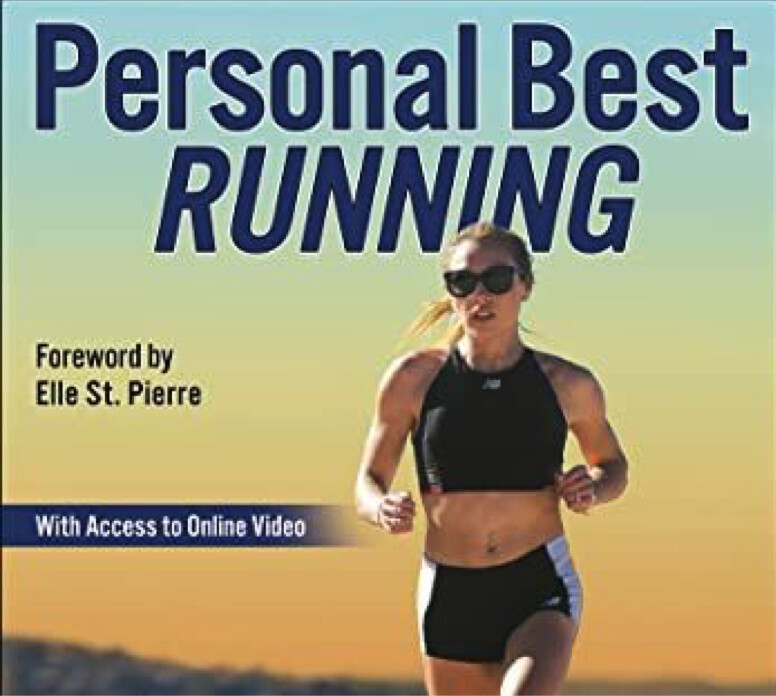
I’ll illustrate this idea with some personal history. When I ran at the University of Maryland, almost all of our workouts were super hard, nearly race-level efforts. Some guys on the team actually set personal bests in workouts. If you were grading our workouts, you’d give us an A+.
That might sound great, but we consistently underperformed in races. Then, dissatisfied with our results, we would try to run our next workout even harder. We’d arrive at our next race physically and mentally exhausted, and we’d again underperform. Then we would be back at it in practice a few days later, eager to prove to ourselves that we were better than our race results showed. And so on.
A lot of guys had multiple injuries. I managed to stay injury-free but never raced like I thought I should. I graduated from college in 1988 without having qualified for the NCAA cross-country championship.
After college I was fortunate enough to join the Nike Boston club, coached by Bob Sevene. I did most of my workouts with that group while running most other days of the week with a bunch of pros in Providence, Rhode Island. I started realizing there was another way. Bob’s workouts never had me going to the well. We might do 10 kilometers of fast running in a session, but under control. Workouts like three 2-mile repeats at around half-marathon pace, or lots of 800-meter repeats at around 10K pace, were typical. If you were grading these workouts, you’d give them a B+. I remember thinking, “This is too easy.”
A Lightbulb Moment
After about two months of this type of training in the winter of 1988/89, I ran an indoor 3,000-meter race as a tune-up before the U.S. qualifying race for the world cross-country championship. I battled Sydney Maree, an Olympian and former world-record holder, in that 3K. Although Sydney outkicked me, I ran a personal best by 10 seconds. I thought, “Wait, how did I just set this massive 3K PR after almost never running that fast in practice?”
The 12K cross-country race was even more eye-opening. I finished third, behind Olympians Pat Porter and Ed Eyestone. I still can’t believe that result—third in the country, behind two guys who were Olympians, even though less than a year earlier I hadn’t even qualified for the collegiate cross-country championship. I proved that race wasn’t a fluke a month later at the world meet, where I finished 39th and was again third American, beating people like a former 10K world-record holder. I thought, “You don’t go from not making the NCAA meet to placing high at the world championship just because of one more year of maturity. It has to be the training.”
My belief in the value of consistent B+ workouts only grew when I moved to Boulder, Colorado, in the early 1990s and started training with people like Arturo Barrios, who had set world records at 10K and the hour run. I couldn’t believe how easy some of his workouts were for how good he was! I could match him stride for stride in them, and he was more than a minute faster than me at 10K. I also saw that marathoners like Mark Plaatjes and Rob de Castella, both world champions at the distance, and Steve Jones, who once held the marathon world record, almost never did the sort of A+ workouts we did in college. They went about their business week after week, stringing together B+ workout after B+ workout, while staying healthy, mentally fresh, and able to take on the best runners in the world.
Why Be a B+ Trainer
I’m not completely opposed to A+ workouts. I prescribe them in some conditions, as you’ll soon see. In general, though, I think almost all of your sessions should be at that B+ level. A+ workouts are really hard mentally. Just anticipating having to go to the well once or twice a week in training can be exhausting. I’m a big believer in the idea that you have only so much willpower. If you’re using all your fight in training, when you get to a race you’re mentally worn out; you can’t bear down and get the job done.
The second big reason I favor regular B+ workouts is that A+ workouts take a greater physical toll. It’s a lot easier to pull a muscle or tweak a tendon or get really sore from all-out workouts. It’s rare for someone on the New Balance Boston team, the elite group I coach, to miss even one workout because they’re nursing a niggle or are otherwise too beat up from training. It doesn’t matter how big a fitness boost you get from a workout if you can’t make it to the starting line healthy.
Think of A+ and B+ workouts as the difference between what you can do and what you should do. Say you can run 40:00 for 10K. On a really good day, you could probably do a workout of 20 400-meter repeats in 90 seconds with a 200-meter jog between. But it would be a major effort. You’d almost always be better off breaking that workout into two sets of 10 repeats, running 95 seconds per repeat in the first set, taking a five-minute break, and then running 92 or 93 seconds per repeat in the second set.
The B+ version will have you walking away feeling good about yourself and eager for your next workout. The A+ version might really beat you up and lead to the beginning of an injury a couple of days later. And that assumes you finish the workout. You might wind up exhausted after 16 repeats, and then get down on yourself for slowing or cutting the workout short.
Immediately after a B+ workout, you’ll feel tired, and you’ll know you’ve worked hard, but you’ll feel like you could have done one or two more repeats at the same pace without killing yourself. I love it when my team says, “Really, that’s it? I could do more.” That tells me I have them working in that sweet spot. If they say they can’t complete the workout, or if they’re rolling around on the ground after, I asked too much of them.
On the day after a B+ workout, it’s okay to be a little tired, but you shouldn’t be super sore. You shouldn’t be dreading that day’s run because you’re physically and mentally exhausted. You should feel like saying, “I’m happy to take it easy today, but I’m also happy to run.” One of the signs that you’re doing too many A+ workouts is that you’re not looking forward to training. After all, most of us run because we love it.
You’ll see this principle of B+ workouts building on one another in the training schedules of my book, Personal Best Running. Few of the hard sessions should cause you to shudder or wonder if you can complete them. You’ll instead see a steady progression of hard-enough workouts that will advance your fitness week by week while leaving you fresh enough to absorb and enjoy your training.
An Occasional A+ Effort
The schedules within the book do contain the occasional A+ workout. For example, week 9 of the 12-week 10K schedules calls for either a tune-up race or a workout of three miles continuous at 10K pace. The latter is hard! That’s the first half of a 10K, on your own, while deep in serious training. Similarly, you’ll see this on the Tuesday workout in the penultimate week of the mile schedules found in the book. It includes two 800-meter repeats at your mile race pace. If that’s not an A+ workout, I don’t know what is.
Doing a workout that hard once in a great while steels you mentally for racing. I most often have runners do them as an important race approaches, especially if they haven’t raced for a while. For example, in January 2022, Elle St. Pierre and Heather MacLean were scheduled to race the mile at the Millrose Games. It was to be their first race since the Tokyo Olympics five months earlier. I wanted them to experience some of the stress and strain of racing before the big stage of Millrose. Eight days before the meet, I had them start a workout with a 1-kilometer time trial. They both ran 2:34, which is fast enough to win most races at the distance. The following week, Elle won her second consecutive Millrose mile title.
I think there will be some innovation in this area because of super shoes—the plated, higher-stack models with next-generation midsole cushioning. They allow you to run faster while not incurring as much muscle damage. So there might be more frequent A+ workouts in my runners’ future. But there’s still the toll of hammering all of your workouts and being flat mentally when it’s time to race.
It can be tempting to post epic workouts on Strava or elsewhere online. Just remember that they give out medals for races, not workouts.
Adapted with permission from Personal Best Running, by Mark Coogan and Scott Douglas.
by Runner’s World
Login to leave a comment
Bathurst ready to welcome the world on ‘toughest ever’ championship course
Absence, they say, makes the heart grow fonder. But in the case of World Athletics Cross Country Championships, it also seemingly makes the courses tougher.
Four years have passed since the memorable 2019 edition in the Danish city of Aarhus, where athletes had to run up a museum roof, trudge through a mud pit, and dash through a Viking zone. It was widely regarded as one of the most unique and challenging courses ever at a World Cross.
Now, on the eve of the World Athletics Cross Country Championships Bathurst 23, many people are convinced that the course for this year’s edition is even tougher.
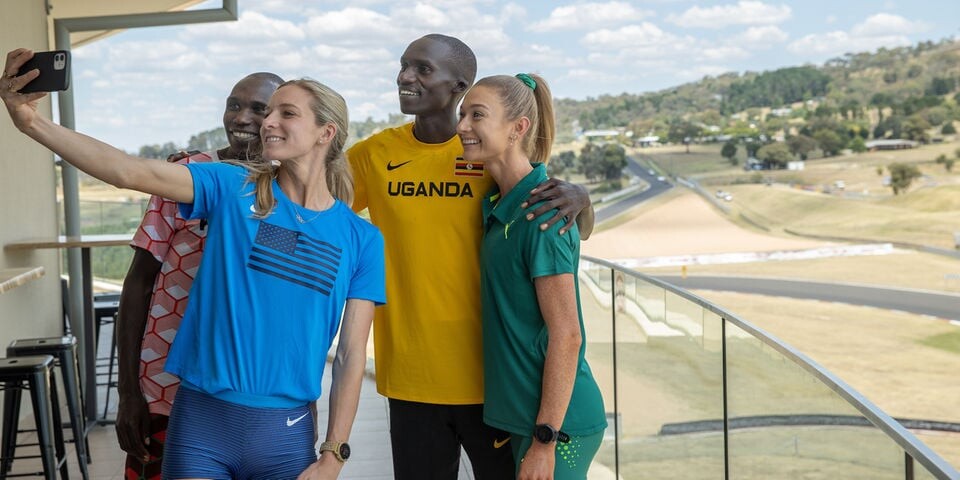
“In recent years we’ve talked about reinvigorating cross country, and we adjusted the course in Aarhus to create a more challenging one,” said World Athletics President Sebastian Coe. “I’m delighted that the team here in Bathurst have picked up that torch and done an outstanding job. I’d say this is certainly one of the toughest courses ever for a World Cross.
“We are really pleased to be here,” he added. “In the 50-year history of the World Cross, this is just the second time it has been held in Oceania, and it’s the first time it has been held in Australia.
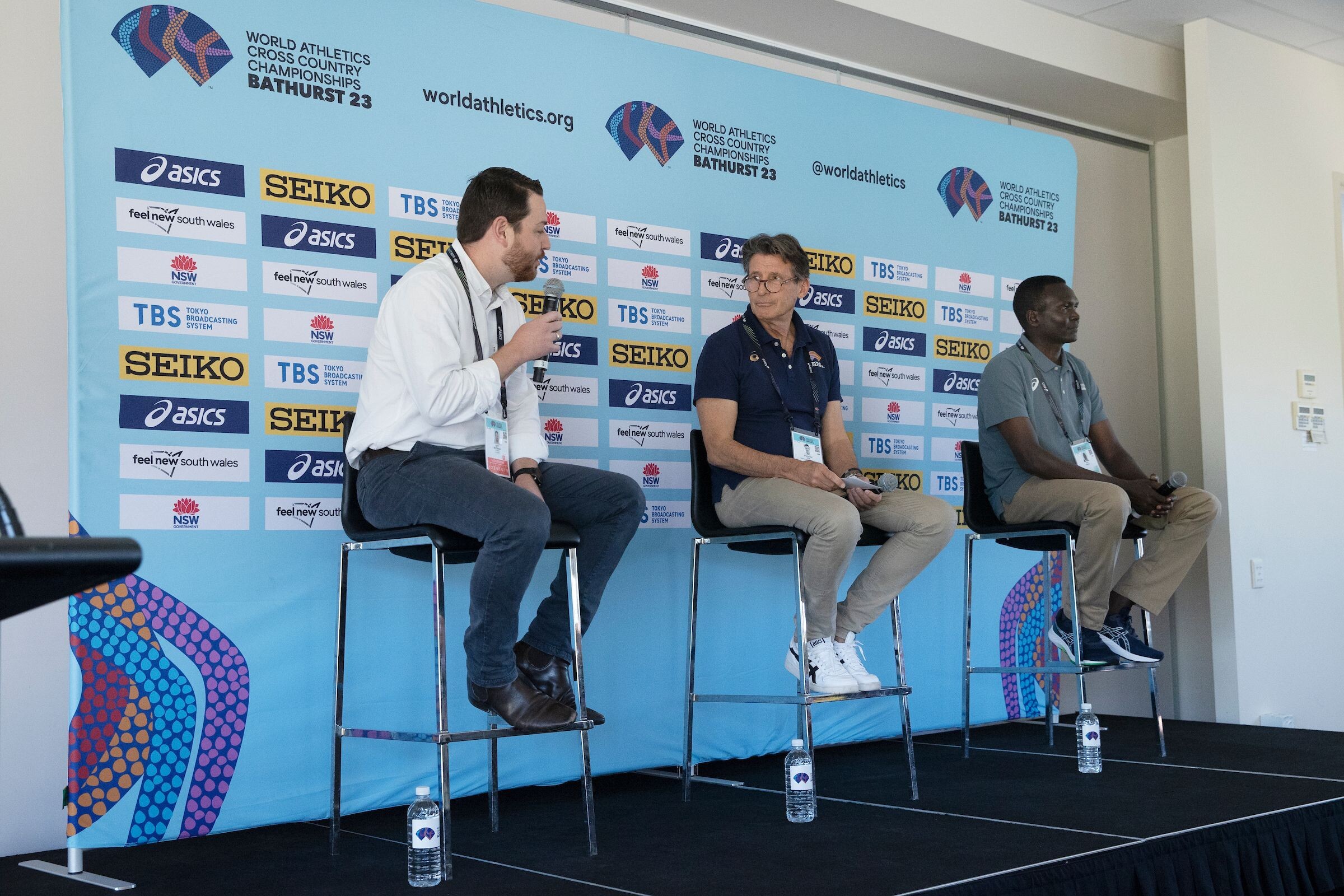
“Bathurst has one of the most iconic motor racing tracks in the world, but now, in the same breath, people will think of Bathurst staging the World Cross Country Championships.”
Local Organizing Committee Co-Chair Matt Whitbread expressed his pleasure at welcoming the world to Australia for a global athletics event.
“We’re delighted to have everyone here in Bathurst,” he said. “After the last edition in Denmark, there was plenty of inspiration. We got the brief that the course needed to be hard, and hopefully we’ve achieved that.
“We were originally scheduled for 2021, then 2022, and we’re finally here now,” he said. “We’re thrilled to be here and we welcome you all.”
Coe also used the opportunity to underline the importance of cross country.
“World Athletics takes cross country very seriously, and the importance of cross country goes beyond a great World Championships like this,” he said.
Championships ambassador Paul Tergat is living proof of someone who benefitted from cross-country running. A five-time world champion at cross country, the Kenyan legend also set world records on the track and roads during his long career.
“Cross country is part of my DNA,” said Tergat. “This is where my career started. Being here, especially in Australia where I have such fond memories, makes it more special.
“With cross country, not only do you have to think about the athletes you’re racing against, you also have to think about the terrain and the course,” he added. “I believe that makes you tougher. Each course is different, which makes cross country unique.”
Cheptegei and Kamworor ready for rematch
Uganda’s Joshua Cheptegei and Kenya’s Geoffrey Kamworor – who, between them, have won the past three senior men’s titles – will once again go head to head on Saturday.
Cheptegei’s compatriot Jacob Kiplimo, who took silver in 2019, is also in Bathurst, meaning the full podium will be reunited.
“It’s exciting that the people who shared the podium in 2019 are all back here,” said Cheptegei, the 5000m and 10,000m world record-holder. “I know it’s going to be mind-blowing and will be something that will stay in our hearts and minds for a long time.”
Memories of the 2017 World Cross Country Championships have certainly stayed with Cheptegei over the past six years. On that occasion, with the World Cross taking place on home soil, Cheptegei had built up a huge lead but fatigue eventually got the better of him and he faded to 30th, as Kamworor successfully defended his title.
“Sometimes you have to accept what life throws at you and then learn from it,” said Cheptegei. “I can proudly say that I am a better athlete because of the incident in 2017. It taught me a lot of lessons about my life and my career. When you want something in life, it’s important to chase your goals, but you also have to be patient and make certain judgements.”
For Kamworor, it was the 2011 edition of the World Cross that holds most significance.
“The first major title I won was the U20 title at the 2011 World Cross Country Championships,” he said. “That motivated me so much, and ever since then I have loved cross country.”
Despite winning two individual senior titles and one U20 title, Kamworor is yet to win a senior team gold at the World Cross. He hopes that will change on Saturday, though.
“We had great training with the team and we hope to do our best tomorrow and hopefully win the team title,” he said.
Hull and Coburn take different routes to Bathurst relay
Dramatically contrasting paths have led accidental contender Emma Coburn and child prodigy Jessica Hull to the World Cross Country Championships in Bathurst where they are both in contention for medals.
Colorado-based Coburn, 32, is looking forward to leading USA in the mixed relay, despite being an athlete who spurned cross country at school and college in favour of volleyball and track.
Coburn instead went on to become a steeplechase specialist, winning the 2017 world title at that discipline, as well as the 2019 world silver and 2016 Olympic bronze.
Coburn said the longer cross country courses were the reasons she never got into the discipline.
“I was never that mentally into it (cross country) because I played volleyball during the same season in high school,” Coburn said. “In college I tried it, but I wasn’t that great. I always loved the steeplechase and the track.”
Being able to compete in a mixed relay – the ninth time Coburn has represented the USA at a global championship – where each runner completes a 2km loop has changed her attitude about cross country.
“This 2km distance I think is really fun,” she said. “The muscular strength in my legs will be beneficial on some of the technically challenging parts of the race, like the mud pit.
“As a steeplechaser, I like the challenge of this course. We’ll be going for it, trying our hardest to conquer the course and come out with some hardware.
“This is a fun opportunity and something different for me. I’m eager to try new things and mix it up and this is an opportunity to challenge my mind and body.”
Coburn will be supported in the mixed relay by US teammates Heather MacLean, a 2021 Tokyo Olympic 1500m semi-finalist, steeplechase expert Alec Basten, and 2019 mixed relay runner Jordan Mann.
The USA will be vying for the medals alongside Australia, whose team boasts a cross country child enthusiast in Hull.
Twenty years ago Hull kicked off her athletics career doing 2km primary school cross country carnivals across the road from her home in New South Wales, Australia.
“It’s kind of scary,” Hull said. “It was part of my school sports days and it was 2km. Now I’ll do a 2km hot lap of the Bathurst course. So it’s kind of a full circle moment.
“If we were to get the win out there, it would be pretty special,” she added. “It is incredible that we can talk about the Aussie team even having a win. It would be quite a remarkable day if we got to hear the national anthem while we are out there.”
Athletics has taken Hull, 26, from school cross country carnivals to the world stage where she’s been a 1500m finalist at three majors – the 2021 Tokyo Olympics (11th), the 2022 World Championships in Oregon (7th) and the 2022 Commonwealth Games in Birmingham (8th).
Hull will be joined on the tough Bathurst course by three other Australian 1500m specialists: Commonwealth champion Oliver Hoare, Commonwealth bronze medallist Abbey Caldwell, and Olympic finalist Stewart McSweyn.
The mixed relay is the first medal event on the championship programme on Saturday (18). 15 teams will compete for the medals, running in a 4x2km man-woman-man-woman format with each athlete having a wristband which they transfer to their teammate in the takeover zone.
“Cross country is an absolutely essential part of the development of young athletes. Any athlete who can master cross country and can do so from a young age is going to be well placed to pursue an endurance career on the track.”
by World Athletics
Login to leave a comment
World Athletics Cross Country
Athletes from across the globe will descend on Australia for the World Athletics Cross Country Championships Bathurst 2021. Mount Panorama is better known as the home of Australia’s premier endurance motor race, but in one year from now, it will welcome the world’s best endurance runners for what will be Australia’s first World Athletics Series event in...
more...Track legend Jenny Simpson puts her most challenging year behind her as she turns to the roads in 2023
After a year in which her world was turned upside down, the track legend has a new sponsor and new event as she makes her half marathon debut in Houston on Sunday.
As the Marshall Fire approached her house on December 30, 2021, there was a brief moment where Jenny Simpson thought to herself, I can’t believe I’m doing this. The house Simpson shares with her husband Jason was formerly a schoolhouse, built in 1900 and located in Marshall, Colo., 15 minutes southeast of Boulder. And on that day, it was under threat from what would eventually become the most destructive fire in state history.
The fire, spread by wind gusts of over 100 miles per hour, was moving quickly. As thick smoke enveloped their property, choking their lungs and blocking their vision, the Simpsons prepared for the worst. Trying to limit the burn, they watered down the yard with hoses, inadvertently soaking their clothes as the wind blew the spray everywhere. Then, as the flames moved in, Simpson took one last lap around the house, grabbing their laptops, their Jack Russell terrier Truman, and a bag containing her running medals and memorabilia — one she had assembled a month earlier while being interviewed for a documentary and fortunately had yet to unpack.
Simpson, like many of us, had previously had that conversation about the one thing you would grab if your house was burning down. She had always answered with her Bible, handed down to her from her great-grandmother Genevieve Schermerhorn (“Grandma Jenny”), for whom she was named. So, as she grabbed the Bible from her office and dashed out of the house, it hit her: I think I’m grabbing the thing that you get because we might lose everything.
By the time Simpson made it to her car, she no longer knew where Jason was or whether he would make it back to the car — the smoke was so dense, it was difficult to see. He eventually made it and they sped away from their house, not knowing when they would return — or if the house would still be there when they did.
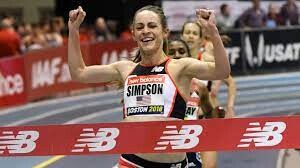
Over the course of two days, Marshall Fire would ultimately burn over 6,000 acres, destroy over 1,000 buildings, and cause over $500 million in property damage, making it the most destructive fire in Colorado history. It was a traumatic event for Simpson and her community.
Though the Simpsons’ home survived the fire, it sustained damage, forcing them to live elsewhere while it was repaired. They bounced around from a hotel to the spare bedroom of some friends from church to, eventually, a sparse apartment near the University of Colorado campus, living out of a backpack with the few things they had managed to grab from their home before the fire hit.
“It’s hard to describe how stressful that time was,” Simpson says.
On top of that, Simpson was working through a sports hernia and stress reaction in her right hip — the most significant injury of her career — and her professional future was less certain than ever. During the 2010s, few athletes were more consistent and dependable than Simpson. From 2007 through 2019, Simpson made all nine World/Olympic teams for the United States, piling up 11 national titles, three World Championship medals, and an Olympic bronze in 2016. That success led to a series of lucrative contracts from her sponsor, New Balance, and, as a highly-ranked athlete, health insurance from USOPC.
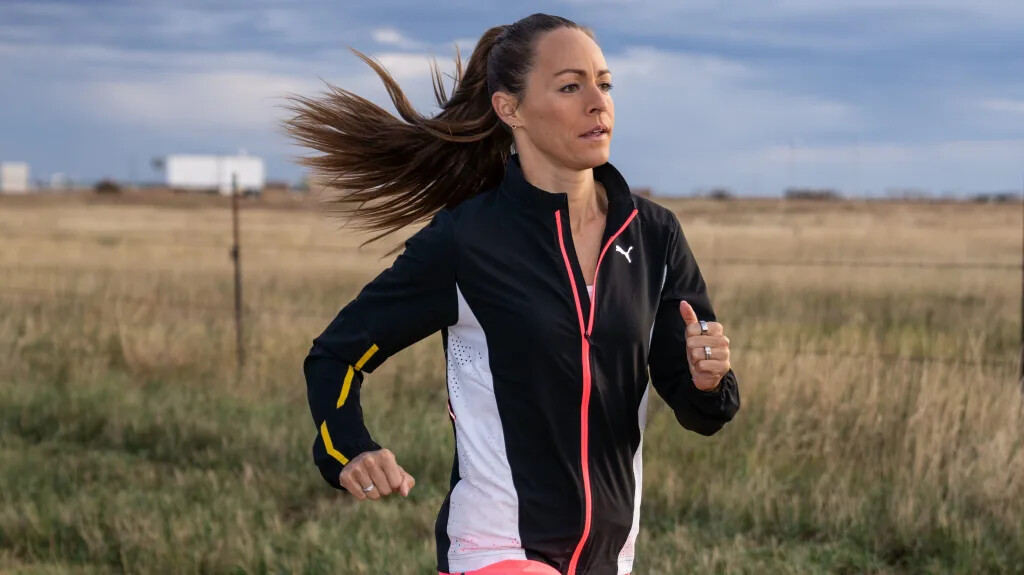
But Simpson’s New Balance contract expired at the end of 2021 — just two days after the fire that displaced her from her home. On January 1, she lost her health insurance coverage from USOPC (to qualify for coverage, an athlete had to have medalled at either the 2019 Worlds or 2021 Olympics, finished in the top 12 at the 2021 Olympics, or finished the season ranked in the top 15 in the world in their event; Simpson no longer met any of the criteria). As 2022 began, she still had Jason, and she still had the support of her longtime coaches, Mark Wetmore and Heather Burroughs. But the other constants in her life suddenly weren’t so constant.
“This last year, I felt more vulnerable than ever,” Simpson says. “The major safety nets in my life have been being a top-performing athlete and being in the tier system and in the USATF system, being a New Balance athlete and knowing I have a future there and my security at home. And my health. All of those things were really wobbly and testy and some of them fell apart in the last year.”
Rebuilding and replacing
One year has passed since the fire that upended Simpson’s world. Some elements of her life have been rebuilt, others replaced. The Simpsons moved back into their house in Marshall on April 1, and after months of work, she says it is 100% back to normal. Her body is also back to full health. That too required months of work.
Simpson had felt pain in her hip area during the fall of 2021 and though she didn’t give it much thought initially, it grew into something that significantly disrupted her training. Even as 2022 began, she remained in denial. After her streak of making teams ended at the 2021 Olympic Trials, Simpson knew she couldn’t afford to miss time if she was to return to her best.
“Pushing through cross training, pushing through the life challenges that we were going through, I definitely made my circumstances a lot worse,” Simpson says. “And I don’t think that’s unusual for runners. That’s kind of in our nature.”
Simpson was determined to avoid surgery, but realized such a path would require a more conservative approach. As winter turned to spring, Simpson, reluctantly, began to back off the intensity to allow her body to heal.
“The toughest thing about having a sports hernia injury and choosing to rehab and go that route and not jump straight into surgery is that it’s just slow,” Simpson says. “And none of us that are athletes, I think in particular runners, want to take anything slow.”
Simpson did not race at all last spring or summer, missing USAs for the first time since 2006 and missing the chance to represent the US at the first World Championships held on American soil. Simpson is now healthy again, but she’s still rebuilding the fitness she lost in 2022.
Another pillar of Simpson’s life — her New Balance contract — had to be replaced rather than rebuilt. Simpson did not want to go into specifics, but says that while New Balance verbally offered her a deal at a reduced level from her previous contract, the two sides ultimately could not reach an agreement. Eventually, Simpson, who had not used an agent since 2014, hired Hawi Keflezighi to negotiate a new deal and announced a sponsorship agreement with Puma in October.
Leaving New Balance behind was painful. Simpson signed with the company coming out of the University of Colorado in 2010, and after 12 years together had envisioned staying with the brand in some fashion for the rest of her life. Seconds after crossing the finish line in 10th in the 2021 Olympic Trials 1500, Simpson looked at the scoreboard and saw that Elle St. Pierre, Cory McGee, and Heather MacLean — all New Balance athletes — had gone 1-2-3 to make the team; Simpson was the first to congratulate them. She figured that, even once her racing days were over, there would still be some sort of role for her at New Balance.
“My whole future in sport and beyond was about how can I take what I’m learning in my career and make that in any possible way benefit the women’s team in the future,” Simpson says. “So seeing that [1-2-3 at the Trials] and knowing there was a strong middle distance future here and how can I continue to pour into that, that’s what I thought my future was.”
A move to the roads and a new beginning
For the first decade of her professional career, Simpson’s running life was fairly straightforward. She was consistently one of the best in the world in her event, meaning she could enter any race she wanted and was always in-demand from her sponsor (two of the reasons she went without an agent for so long). Every year since rejoining Wetmore and Burroughs in 2013 (she was coached by Juli Benson from 2010-12), she would sit down with them and figure out how to be at her best in the biggest race of the year, either the World Championship or Olympic final. More often than not, she succeeded.
But after failing to make the Olympic team in 2021, Simpson began to ponder her athletic mortality. She was nearing her 35th birthday and had a few options if she wanted to stay in the sport.
“The biggest consideration was, do I move up to the 5k, do I try to run a great 10k, or do we do something totally different?” Simpson says.
(LetsRun founder Robert Johnson will be devastated to learn Simpson did not mention the steeplechase, the event in which she won two US titles and set the American record in 2009).
Simpson dipped her toes into Option C by running the Cherry Blossom 10-Miler in September 2021 (she finished 2nd in 52:16). Midway through 2022, she had fully committed to the roads.
“It’s always been part of the plan that I would give the roads some good years of my career,” says Simpson. “And I think I just saw those really good years becoming fewer and fewer and I realistically wanted to make the transition before I was so, not just physically tired, but also just emotionally drained and psychologically drained from the intensity of it.”
The last few years, Simpson carved out a niche as a mentor to some of the up-and-coming athletes in the Colorado program. As a volunteer assistant at CU, Simpson was able to watch runners like Dani Jones and Sage Hurta at practice, then aid their transition to the professional ranks by traversing the circuit alongside them as a competitor/friend. With Simpson’s move to the roads, that period of her career is over.
“I think that’s what I’ll miss the most, is feeling like I get to be a little bit of a mother hen for the [Colorado] women that are doing really well and have a future as a pro in the sport,” Simpson says.
Now, Simpson is heading into the unknown. The training, obviously, is different. Though Simpson ran relatively high mileage for a 1500 runner — it was not uncommon for her to hit 80 miles in a week — she is now running 80+ regularly, doubling up to five times per week. During her track career, a long workout for Simpson would consist of 12 or 14 by 400m. Now she’s running 2k and 3k repeats on the track.
“That’s a long way to go for someone like me,” Simpson says. “…You go out on the first lap or two and you think, Are you kidding me? This is it? But it doesn’t stay easy for very long.”
Simpson has also had to educate herself about the road races themselves. When we first spoke for this story in November, Simpson admitted that, outside of the World Marathon Majors, she didn’t know many of the major road races and was still learning about how they stacked up against each other in terms of prestige.
Part of that is due to how the sport is structured. Track is simple: Worlds or the Olympics is the end goal and the rest of the season is built around that. The roads are different — people reach top fitness at different times. For marathoners, it’s fairly intuitive — pick one race to peak for in the spring and one in the fall. But Simpson isn’t a marathoner (yet). For road racers at shorter distances, it’s more choose-your-own-adventure.
Simpson’s plan: sit down with Wetmore and Burroughs, pick a race to gear that year’s training around, and attack it like they would a World Championship or Olympics.
“Even though it’s not to the world a big World Championships, it will be Mark and Heather and Jenny’s World Championships,” Simpson says.
As for the marathon, Simpson would not commit to running one eventually, but did not rule it out either. She watched Jason, after years of grinding, finally qualify for the Olympic Marathon Trials at CIM in 2018 and knows how difficult the event is. She has no desire to rush into one.
“It is really freaking hard,” Simpson says. “You don’t know for sure that your body is suited for it just because you’ve been a good runner…What it will take for me to run a marathon? If I have a great half and I feel like my body’s handling that workload really well, we’ll absolutely do a marathon. Because at that point, you’ve gotta find out, right?”
Next stop: Houston
The big question hanging over all this: will Jenny Simpson be any good on the roads? It’s no certainty that prime Simpson, the one who won a record eight Fifth Avenue Miles, would have been a force over 10k and beyond, much less the 36-year-old version coming off the most disruptive injury of her career.
Thirty-six is not necessarily old by distance standards, though. Last year, Keira D’Amato broke the American marathon record at 37 and Sara Hall broke the American half marathon record at 38. Like Simpson, both were for a time milers on the track before moving up — though it took each several years before their big breakthrough.
After down years in 2021 and 2022, logic says Simpson could have a tough go of things. The bar for success, certainly, will have to be recalibrated. At her best on the track, Simpson was one of the top three women in the world in her event. That level of accomplishment is virtually impossible for her on the roads, but could she become one of the best in the US in the 10k, half, or marathon?
Her road debut at Cherry Blossom in 2021 was auspicious (2nd place, 52:16), her appearance at last fall’s USATF 5K champs in New York less so (she was 17th in 16:07, 39 seconds behind winner Weini Kelati) — though Simpson wasn’t fully fit in New York and knew that going in.
2023 will be the real test of whether Simpson has anything left to give on the roads. And for Simpson, 2023 begins in Houston, where she will make her half marathon debut on Sunday. There is a lot riding on the outcome, which is how Simpson likes it. She has yet to pick that one race that she will plan her 2023 season around; Houston will help her make that decision.
“This will kind of chart my course of whether we stick with the half marathon, whether I start dreaming about a marathon, or whether I say maybe it’s better for me to get back on the track, spike up, and do some faster stuff over the next year,” Simpson says.
Simpson says that while her training has gone well, the adjustment to training for the half marathon has been more challenging than she expected.
“When I ran Cherry Blossom and I ran 5:14/mile pace the whole way, the idea of running 5:10’s for a half marathon (67:43 pace) seemed right around the corner,” Simpson says. “Now having gone through a year of injury and a lot of other life challenges, I’m having to adjust what I think my half marathon debut is going to look like.”
Simpson will have Jason with her as a pacer on Sunday and said they will plan to go out faster than her pace at the Army 10-Miler in October, a race she won in 54:16 (71:08 half marathon pace). She says she has a time goal in mind but elected not to share it. Her main hope is that she can finish the race well. During her track career, Simpson was famous for her strength in the final 100 meters, but in her last two road races, she felt as if she was holding on for dear life at the end.
Simpson will step to the line on Sunday with an uncertainty that did not exist during her track career. When Simpson started a 1500-meter race, she came armed with knowledge gleaned from years of experience. She knew exactly what sort of time she could expect her workouts to translate to and how to respond tactically to every race scenario. In the half marathon, she’s starting over.
“That’s one of the trepidations of going into the race in Houston is that I’m so used to having such a clear idea of what I am capable of,” Simpson says. “My race in Houston will be as much of a discovery as the training has been.”
Even Simpson admits she doesn’t know how many more years she’ll continue to race professionally. A few years ago, she had scripted out a storybook ending for herself: a fourth Olympic team in Tokyo and a home World Championships in front of friends and family in Eugene. Make those two teams, she thought, and she would have total freedom to do whatever she wanted afterwards, whether it was continuing to race on the roads, pursuing a coaching career, or starting a family.
That, of course, did not happen. In professional sports, endings rarely go according to plan. But Simpson is embracing the adventure that comes with her new path, wherever it leads.
“The idea I had in mind was kind of cool, but there are some things that we’re now looking forward to that I couldn’t have even imagined,” Simpson says. “And if it turns out that way, it will end even better.”
by Jonathan Gault
Login to leave a comment
Aramco Houston Half Marathon
The Chevron Houston Marathon provides runners with a one-of-a-kind experience in the vibrant and dynamic setting of America's fourth-largest city. Renowned for its fast, flat, and scenic single-loop course, the race has earned accolades as the "fastest winter marathon" and the "second fastest marathon overall," according to the Ultimate Guide to Marathons. It’s a perfect opportunity for both elite athletes...
more...America's Heather MacLean runs sub four minute 1500m in Monaco
Heather MacLean became the 12th American woman ever to break 4:00 in the 1500m today in Monaco, running 3:58.89. When she finished out her collegiate eligibility at UMass in 2018, she was a 4:19.19 1500m runner.
The Monaco track is known for its speedy middle-distance performances and in the women’s 1500m Faith Kipyegon came within three tenths of a second of breaking Genzebe Dibaba’s world record with 3:50.37.
Allie Wilson led through 400m in 59.89 and 800m in 2:01.64 before Adelle Tracey took over to keep the pace as hard as possible. Kipyegon hit the front with 600m to go and despite hammering the final lap she fell agonisingly short of the mark but still went No.2 on the all-time rankings.
America's Heather Maclean (3:58.89) and Elise Cranny (3:59.06) were second and third with sub-four performances.
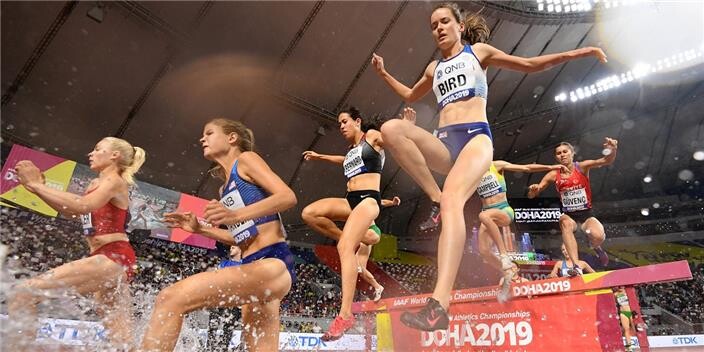
“I have been chasing the time for quite some time but I am happy with the personal best,” the Olympic and world champion said. “I knew this was the best place to get the world record but I am so disappointed I lost it in the last metres. I hope for the best next time. We will see when.
“I was definitely ready for it today. I am heading home now and want to get a good Diamond League final in Zurich.”
It was a first class track meet. World champion returns to winning ways at the Diamond League while fellow Brit Lizzie Bird smashes the national 3000m steeplechase record

Jake Wightman bounced back to form after his defeat at the Commonwealth Games by taking the 1000m at the Diamond League in Monaco on Wednesday (Aug 10).
The world 1500m champion destroyed many of the world’s top 800m runners over the neutral distance of one kilometre as he improved his Scottish record from 2:16.27 to 2:13.88 to go No.3 on the UK all-time rankings and No.9 on the world all-time lists.
Seb Coe’s long-standing UK record of 2:12.18 remains an elusive target and Steve Cram is No.2 all-time with 2:12.88 but Wightman has now overtaken Steve Ovett and James McIlroy on the rankings.
In Monaco the pacemaker Erik Sowinski led through 400m in 51.02 and Marco Arop was in pole position through 800m in 1:45.46, but Wightman, who spent much of the race running alone in no man’s land a few metres ahead of the main pack, finished strongly to pass Arop in the final metres as Clayton Murphy was third, Commonwealth 800m champion Wycliffe Kinyamal fourth and the Olympic and world 800m champion Emmanuel Korir 12th.
“I did not really know I was in shape to do this today. It was just very, very hard as I had run on my own,” said Wightman. “I knew Arop is a little bit quicker on the home straight so I had to judge the right moment. I had to stay strong to be able to catch him.”
Wightman steps down to the 800m at the European Championships next week and said: “This is a really nice step towards Munich. The main difference between the 1500m and 1000m is just the speed of the first couple of laps. You go from running 55s to 52.”
Lizzie Bird smashed the British record for 3000m steeplechase as she improved Aimee Pratt’s national mark by almost eight seconds to 9:07.87.
Pratt set a British record twice at the World Championships last month as she ran 9:18.91 in her heat and 9:15.64 to place seventh in the final. But Bird ran 9:17.79 to take silver at the Commonwealth Games and here in Monaco swiped a further 10 seconds off her best as she pipped former world champion Emma Coburn at the finish to place third behind Ethiopia duo Workua Getachew and Zerfe Wondemagegn.
Bird, 27, was encouraged to try the steeplechase while studying at Princeton in the United States. She was a reluctant steeplechaser at first and suffered injuries from 2016-18 but set a UK record of 9:19.68 when placing ninth in the Olympics last year and the Shaftesbury Barnet athlete is now closing in on the nine-minute barrier while combining athletics with a career in immigration law based in Colorado.
There is more: Distance runner Grant Fisher’s record-breaking 2022 season continued tonight at the Herculis meeting in Monaco where he ran 7:28.48 for 3000 meters, finishing 3rd, to break Bernard Lagat’s 7:29.00 American record which had stood since 2010.
Fisher’s 3000 record is his third American record of the year as in February he set the indoor 5000 record (12:53.73) and outdoors he set the American 10,000 mark in March(26:33.84).
Login to leave a comment
USATF 2022 Championships finals results through June 25
There has already been a lot of a action during the 2022 USATF Championships in Eugene Oregon. Sydney McLaughlin set a new world record in the 400m hurdles (Second photo). Michael Norman won the 400m (first photo) and Fred Kerley won the 100m (third photo). Photos by Jivko
Women’s 100m
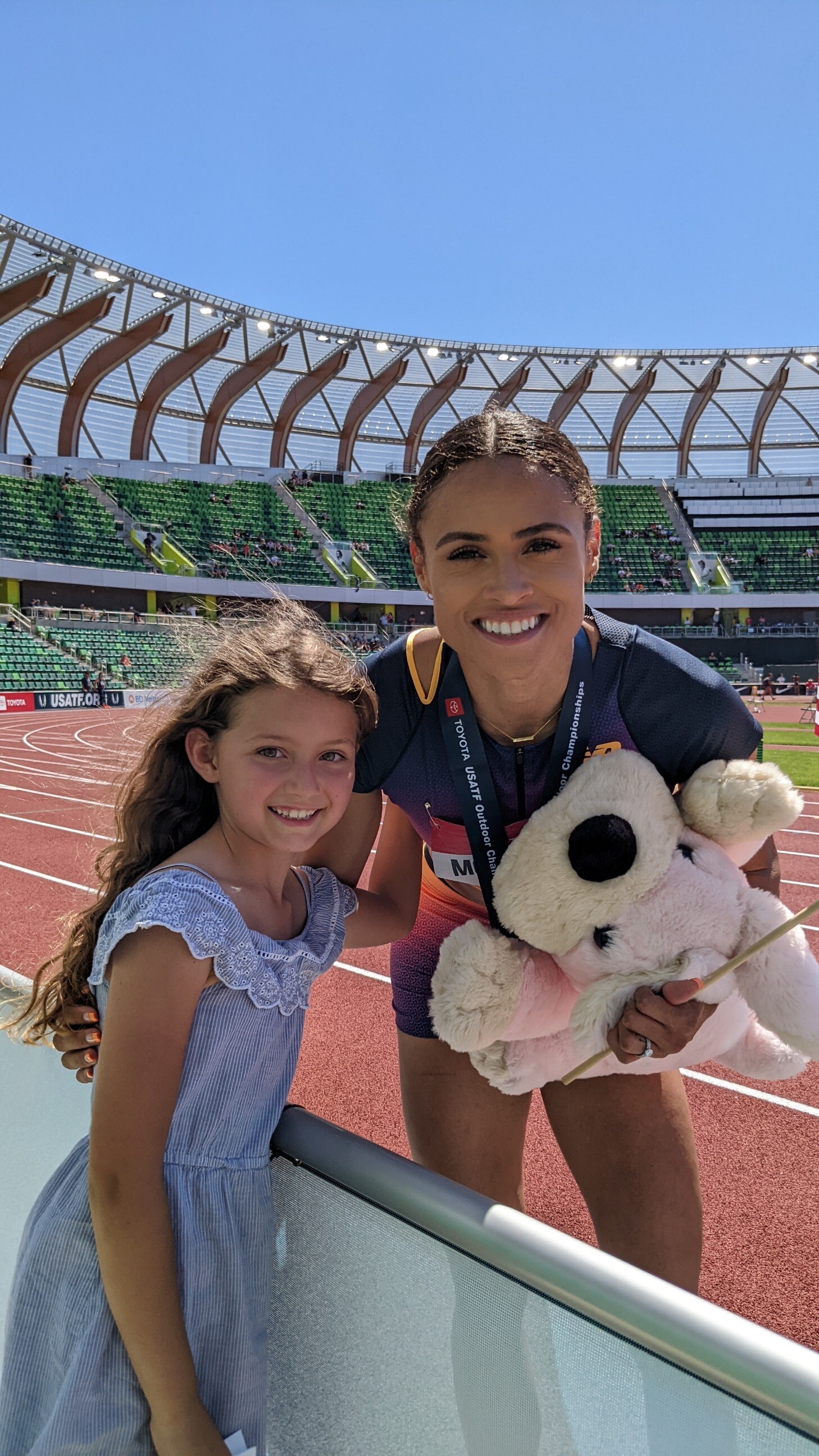
1. Melissa Jefferson — 10.69 2. Aleia Hobbs — 10.72 3. Twanisha Terry — 10.744. Tamari Davis — 10.785. Tamara Clark — 10.826. Celera Barnes — 10.86
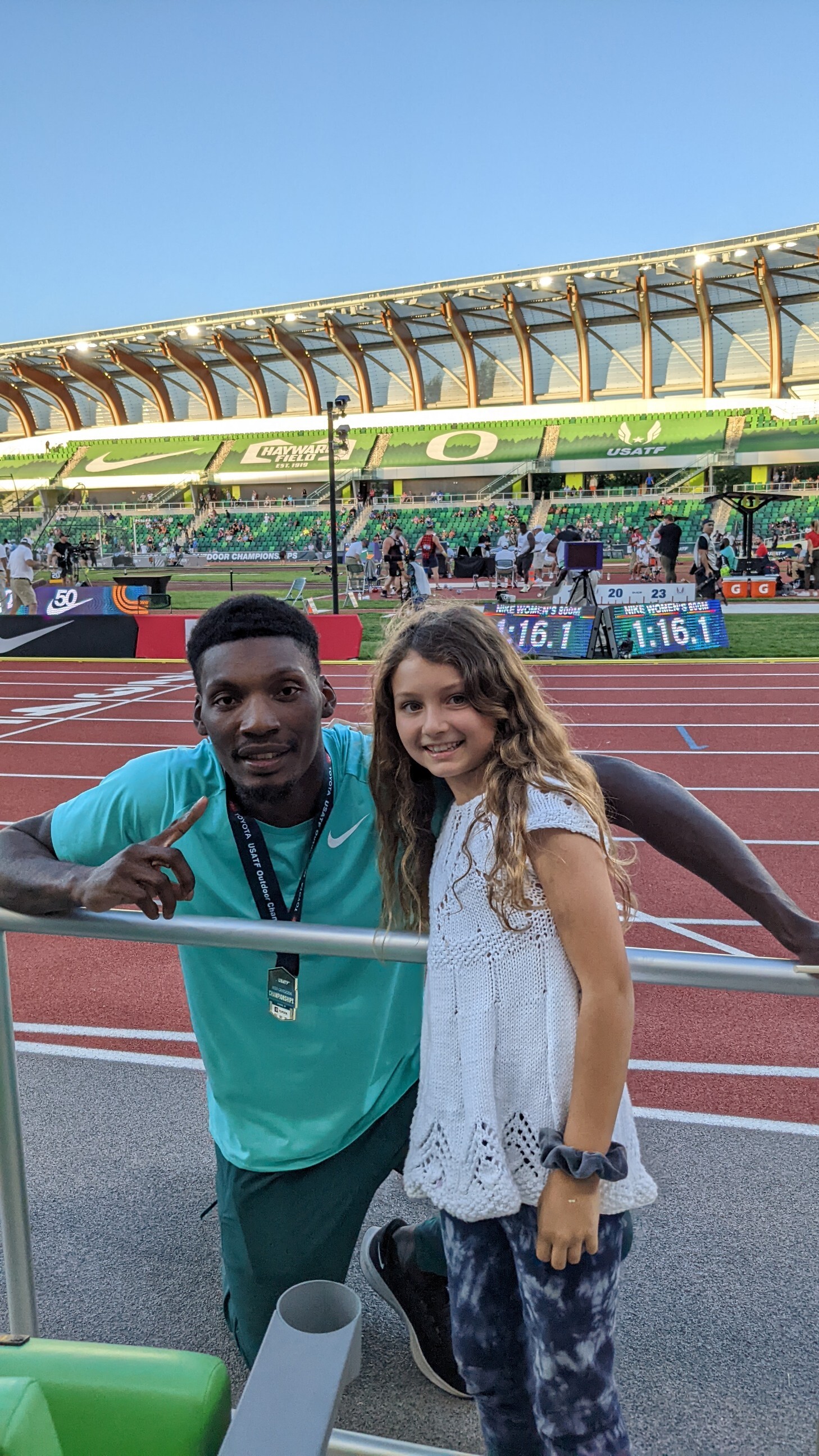
Women’s 400m
1. Talitha Diggs — 50.22 2. Kendall Ellis — 50.35 3. Lynna Irby — 50.674. Wadeline Jonathas — 50.845. Kennedy Simon — 50.906. Allyson Felix — 51.307. Jaide Stepter — 51.308. Kaylin Whitney — 51.31
Women’s 1500m
1. Sinclaire Johnson — 4:03.29 2. Cory McGee — 4:04.52 3. Elle St. Pierre — 4:05.144. Karissa Schweizer — 4:05.405. Heather MacLean — 4:06.40
Women’s 10,000m (from May 27)
1. Karissa Schweizer — 30:49.56 2. Alicia Monson — 30:51.09 3. Natosha Rogers — 31:29.804. Emily Infeld — 31:30.045. Weini Kelati — 31:39.90
Women’s 100m Hurdles
1. Keni Harrison — 12.34 2. Alaysha Johnson — 12.35 3. Alia Armstrong — 12.474. Tonea Marshall — 12.555. Tia Jones — 12.59DNS. Nia Ali (has bye onto world team)
Women’s 400m Hurdles
1. Sydney McLaughlin — 51.41 WR 2. Britton Wilson — 53.08 3. Shamier Little — 53.924. Anna Cockrell — 53.985. Shannon Meisberger — 55.39
Men’s 100m
1. Fred Kerley — 9.77 2. Marvin Bracy-Williams — 9.85 3. Trayvon Bromell — 9.884. Micah Williams — 9.905. Elijah Hall-Thompson — 9.906. Kyree King — 9.96DNS. Christian Coleman (has bye onto world team)
Men’s 400m
1. Michael Norman — 43.56 2. Champion Allison — 43.70 3. Randolph Ross — 44.174. Elija Godwin — 44.345. Vernon Norwood — 44.356. Bryce Deadmon — 44.547. Noah Williams — 45.048. Ismail Turner — 45.56
Men’s 1500m
1. Cooper Teare — 3:45.86 2. Jonathan Davis — 3:46.01 (doesn’t have standard)3. Josh Thompson — 3:46.07 (doesn’t have standard)4. Eric Holt — 3:46.15 (doesn’t have standard)5. Reed Brown — 3:46.28 (doesn’t have standard)6. Johnny Gregorek — 3:46.36 (has standard)11. Yared Nuguse — 3:47.46 (has standard)
Men’s 10,000m (from May 27)
1. Joe Klecker — 28:28.71 2. Grant Fisher — 28:28.81 3. Sean McGorty — 28:29.574. Dillon Maggard — 28:30.755. Shadrack Kipchirchir — 28:30.79
Men’s 3000m Steeplechase
1. Hillary Bor — 8:15.76 2. Evan Jager — 8:17.29 3. Benard Keter — 8:19.164. Duncan Hamilton — 8:20.235. Anthony Rotich — 8:23.15
Login to leave a comment
USATF Outdoor Championships
With an eye toward continuing the historic athletic success of 2022, USATF is pleased to announce competitive opportunities for its athletes to secure qualifying marks and prize money, including a new Grand Prix series, as they prepare for the 2023 World Athletics Championships in Budapest, Hungary.As announced a few months ago, the 2023 Indoor Championships in Nanjing, China have been...
more...World Record Holders, Olympians, National Champions set to Race B.A.A. 5K
The B.A.A. 5K and B.A.A. Invitational Mile will make a triumphant return to Patriots’ Day weekend, with professional fields featuring world record holders, Olympians, Paralympians, national champions, and local standouts. Held on Saturday, April 16, the B.A.A. 5K and B.A.A. Invitational Mile will kick-off festivities leading up to the 126th Boston Marathon on April 18.
“The B.A.A. 5K and B.A.A. Invitational Mile are two events entrenched in the fabric of Boston Marathon weekend, and each features a field which will lead to fast competition,” said Tom Grilk, President and Chief Executive Officer of the B.A.A. “With three years having passed since our last in-person edition of these races, we’re eager to return to the roads to crown champions.”
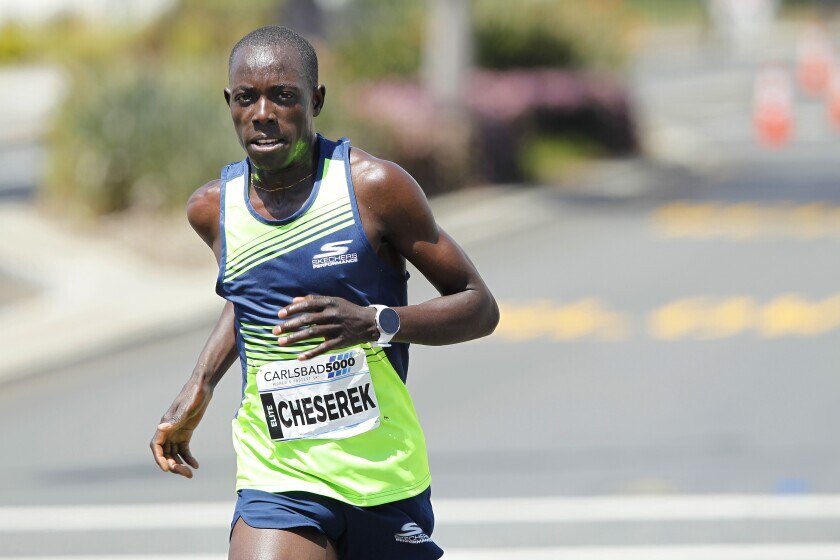
In the B.A.A. 5K, Ethiopia’s Senbere Teferi will make her Boston road racing debut. A two-time Olympian and two-time World Athletics Championships silver medalist, Teferi holds the women’s-only 5K world record of 14:29. She’ll be up against recently crowned American marathon record holder Keira D’Amato, 2021 U.S. Olympians Emily Sisson and Rachel Schneider, reigning U.S. 5K national champion Weini Kelati, and B.A.A. High Performance Team member Erika Kemp. The B.A.A. 5K course and American record of 14:50 –set by Molly Huddle in 2015—could very well be in jeopardy.
On the men’s side, 2019 B.A.A. 10K champion David Bett and 17-time NCAA champion Edward Cheserek, both of Kenya, will square off against New Zealand 5,000m indoor national record holder Geordie Beamish and 2021 U.S. Olympians Mason Ferlic and Joe Klecker. Stanley Kebenei, a World Athletics Championships finalist in the 3000m steeplechase, will also be part of the strong American charge. The B.A.A. 5K course and American record is 13:20, established by Ben True in 2017.
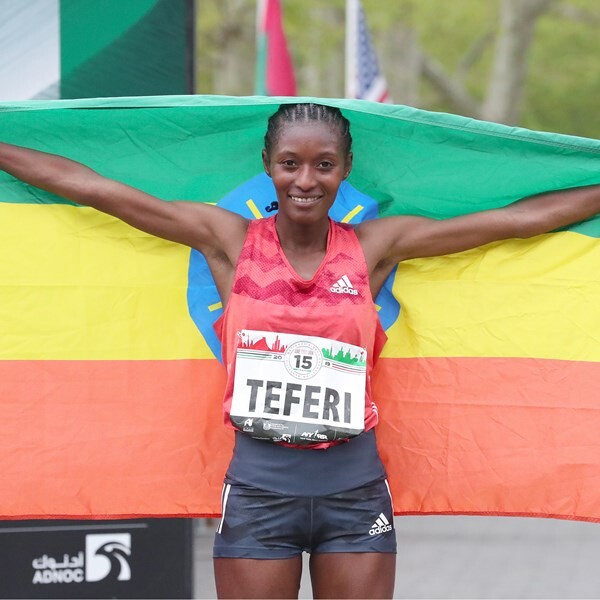
Boston Marathon wheelchair division champions Marcel Hug, Daniel Romanchuk, and Joshua Cassidy will all compete in the B.A.A. 5K less than 48 hours in advance of racing the 126th Boston Marathon. Vanessa de Souza, Shelly Oxley-Woods, and Jenna Fesemyer are top women’s wheelchair entrants.
Following the B.A.A. 5K, the B.A.A. Invitational Mile will take center stage on Boylston Street. U.S. Olympian, Bostonian, and reigning indoor 1,500m national champion Heather MacLean will race for the first time on the three-lap course that finishes at the Boston Marathon finish line. Among her competitors are B.A.A. High Performance Team member Annie Rodenfels, 2019 runner-up Emily Lipari, and Great Britain Olympian Katie Snowden. MacLean and Rodenfels won’t be the only Massachusetts residents toeing the line, as Belmont High School standout Ellie Shea will race among the professionals. Shea ran 9:08.54 for 3,000m during the indoor season, a time that stands as No. 5 on the all-time high school list and is a Massachusetts state record.
Shane Streich, fresh off an indoor American record at 1,000m, will lead the American men in the B.A.A. Invitational Mile along with 3:54 miler Colby Alexander. Neil Gourley of Great Britain is entered, as are Canadian William Paulson, the 2019 Pan-Am 1500m bronze medalist, B.A.A. racing team member Kevin Kelly of Ireland, and local standout James Randon of Rhode Island.
A complete professional field list for the B.A.A. 5K and B.A.A. Invitational Mile can be found below. Preceding the professional divisions of the B.A.A. Invitational Mile will be a scholastic mile and middle school 1K featuring student-athletes from the eight cities and towns along the Boston Marathon route. Entries for the high school and middle school events will be available on race weekend.
2022 B.A.A. 5K WOMEN’S FIELD (NAME, COUNTRY, ROAD 5K PB, TRACK 5000M PB)
Carmela Cardama-Baez, Spain, N/A, 15:25.41 (NR)
Kim Conley, USA, 15:29, 15:05.20
Keira D’Amato, USA, 15:08, 16:09.86
Emily Durgin, USA, 16:05, 15:24.19
Annie Frisbie, USA, 16:35, 16:05.78
Sammy George, USA, 15:53, 15:19.66
Tori Gerlach, USA, 15:56, 15:44.13
Marielle Hall, USA, 15:08, 15:02.27
Elly Henes, USA, N/A, 15:03.27i
Emma Grace Hurley, USA, 16:13, 15:57.23
Katie Izzo, USA, 16:00, 15:41.33
Weini Kelati, USA, 15:18, 14:58.24
Erika Kemp, USA, 15:45, 15:10.10
Melissa Lodge, USA, N/A, 15:53.81i
Sharon Lokedi, Kenya, 15:48, 15:13.04i
Betty Sigei, Kenya, N/A, 15:37.80
Emily Sisson, USA, 15:38, 14:53.84
Rachel Smith (Schneider), USA, N/A, 14:52.04
Emma Spencer, USA, 16:41, 16:04.95
Susanna Sullivan, USA, 16:35, 15:42.59i
Senbere Teferi, Ethiopia, 14:29 (WR), 14:15.29
Abbey Wheeler, USA, N/A, 15:40.67i
2022 B.A.A. 5K MEN’S FIELD (NAME, COUNTRY, ROAD 5K PB, TRACK 5000M PB)
Eric Avila, USA, 13:55, 13:18.68
Geordie Beamish, New Zealand, N/A, 13:12.53i (NR)
David Bett, Kenya, 13:54, 13:06.06
Ben Blankenship, USA, 13:56, 13:33.07
Robert Brandt, USA, N/A, 13:19.11
Sam Chelanga, USA, 13:43, 13:09.67
Edward Cheserek, Kenya, 13:29, 13:04.44
Adam Clarke, Great Britain, 13:42, 13:39.21
Graham Crawford, USA, 13:54, 13:22.68i
Aaron Dinzeo, USA, 14:25, 13:58.37
Brandon Doughty, USA, N/A, 13:39.06
Mason Ferlic, USA, 13:52, 13:24.94
Sydney Gidabuday, USA, 13:53, 13:22.66
Eric Hamer, USA, 14:43, 13:29.60
Brian Harvey, USA, 14:01, 14:13.93
Stanley Kebenei, USA, 13:53, 13:45.87
Joe Klecker, USA, N/A, 13:06.67
Kasey Knevelbaard, USA, 13:56, 13:24.98i
Lawi Lalang, USA, 13:30, 13:00.95
Matt McClintock, USA, 13:49, 13:47.68
Tim McGowan, USA, 14:11, 13:54.20
Reuben Mosip, Kenya, 13:34, 13:50.80a
Charles Philbert-Thiboutot, Canada, 14:04, 13:22.44
Brian Shrader, USA, 13:57, 13:29.13
Zouhair Talbi, Morocco, N/A, 13:18.17i
Aaron Templeton, USA, 13:48, 13:39.39
Josef Tessema, USA, 14:05, 13:22.28.
by Running USA
Login to leave a comment
B.A.A. 5K
The B.A.A. 5K began in 2009, and became an instant hit among runners from far and wide. Viewed by many as the “calm before the storm,” the Sunday of Marathon weekend traditionally was for shopping, loading up on carbohydrates at the pasta dinner, and most importantly- resting. But now, runners of shorter distances, and even a few marathoners looking for...
more...1500m world record Gudaf Tsegay sets sights on first global title in Belgrade
The past six winners of the women’s world indoor 1500m title have all either been Ethiopian or Ethiopian-born: Genzebe Dibaba (2018 and 2012), naturalised Netherlander Sifan Hissan (2016) and Swede Abeba Aregawi (2014), Kalkidan Gezahegne (2010) and Gelete Burka (2008). The sequence is unlikely to be broken in Belgrade.
In physical terms, Gudaf Tsegay might be only 1.63m (5ft 4in) tall but metaphorically the 25-year-old stands head and shoulders above the rest of the 22-strong entry list. In February last year she relieved Dibaba of the world indoor record with her sensational 3:53.09 run in Lievin and, 13 months on, the form book suggests that the clear world leader will succeed her compatriot as world indoor champion.
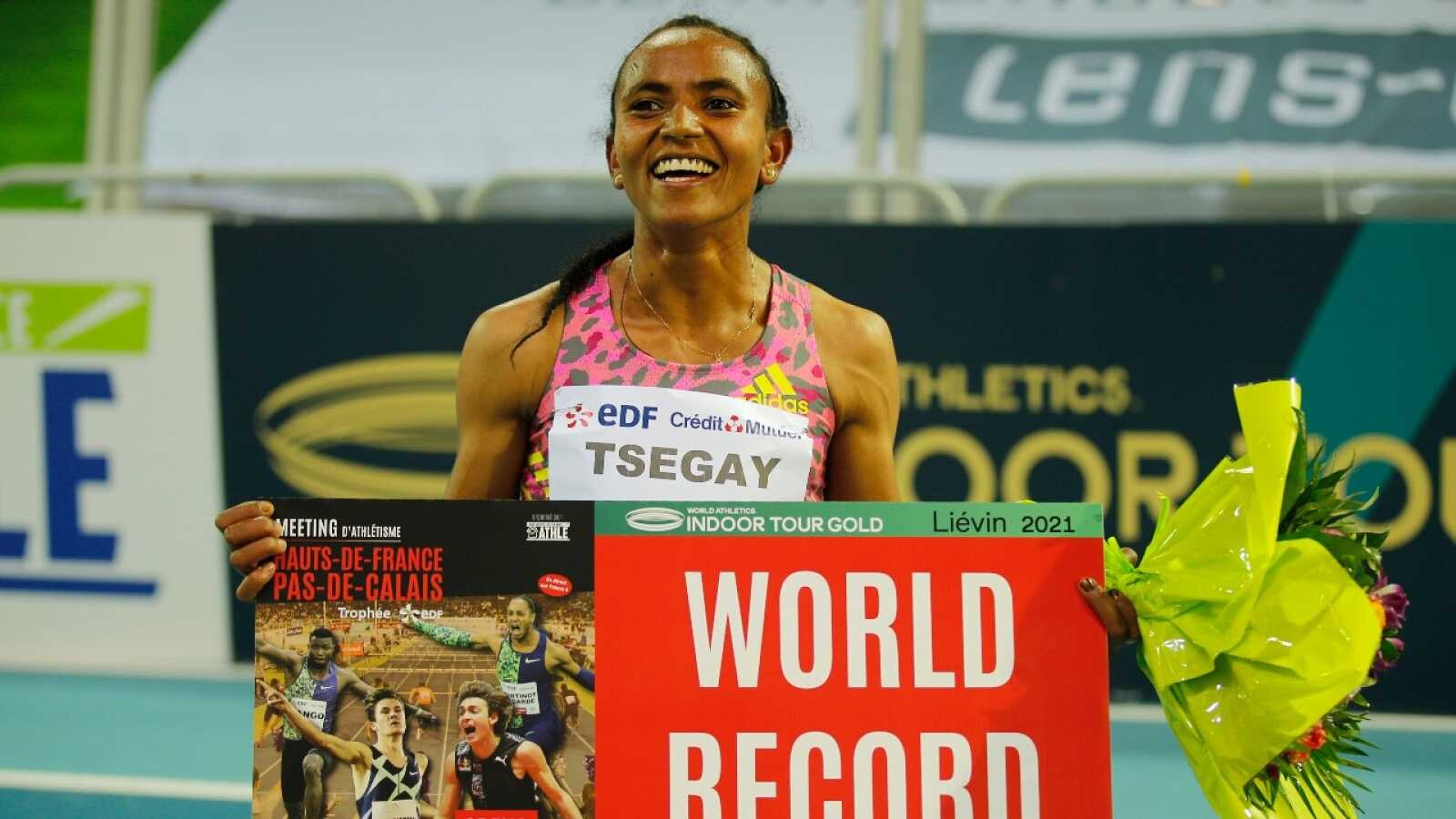
Tsegay ran a scorching 3:54.77 in Torun on February 22, the second fastest in history, and 3:57.38 in Madrid on March 2. Nobody else has cracked four minutes indoors in 2022. The next quickest is also Ethiopian. Axumawit Embaye, who won in Karlsruhe in 4:02.12, finished second to Aregawi in Sopot in 2014 and fourth in Portland in 2016 – behind Hassan and Ethiopian team-mates Dawit Seyaum and Tsegay.
Tsegay has won all nine races she has contested at all distances in the past three indoor seasons. Her last indoor defeat dates back to February 8, 2019, when she finished fourth over 3000m in Madrid.
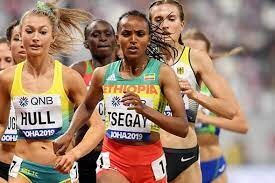
She has not lost a 1500m race indoors or outdoors since the 2019 World Championships final in Doha, when she finished third behind Hassan and Kenya’s Faith Kipyegon. Her last indoor defeat at the distance was on 10 February 2018, when she placed third at the World Indoor Tour event in Boston.
Even when she fell on the opening lap of the mile race at this year’s Lievin meeting in February, she picked herself up, resisted a mid-race challenge from Embaye, and proceeded to win comfortably in 4:21.72, breaking the 20-year-old meeting record.
Tsegay is on a run of three global bronzes, having finished third in the 2016 world indoor 1500m final, the 2019 world outdoor final in Doha and in the 5000m final at the Tokyo Olympics last year. Barring unforeseen disaster, the 2014 world U20 silver medallist’s long pursuit of a Midas touch seems destined to finally meet with a golden global success in Belgrade.
Heather Maclean could be a danger in a tactical affair, having gone from fifth to first with a 29.71-second last lap at the US Indoor Championships. Josette Norris, who finished second in that race, has also displayed great form this year.
Other potential podium placers include Ethiopia’s 2019 African Games 800m champion Hirut Meshesha, who was second in Karlsruhe in 4:02.22, and Uganda’s Winnie Nanyondo. Fourth in the 800m at the 2019 World Championships, Nanyondo improved her Ugandan indoor 1500m record to 4:03.54 in Torun.
by World Athletics
Login to leave a comment
World Athletics Indoor Championships
World-Class Competition Lands in China: 2025 World Athletics Championships The global spotlight shines on China as it hosts the 2025 World Athletics Championships, bringing together the planet’s most elite runners, jumpers, and throwers. This prestigious event, organized by World Athletics, represents the pinnacle of track and field competition—where national pride, personal records, and world titles are on the line. ...
more...Matthew Boling snags Dunkin' Donuts' first track sponsorship
TThe popular U.S. doughnut chain Dunkin’ Donuts has signed Georgia sprinter Matthew Boling, as the captain of Team Dunkin’, marking the brand’s first connection to an NCAA athlete.he po
“America runs on Dunkin’,” and now so does Boling, a four-time 2019 U20 Pan-Am Games gold medallist, who is currently competing for the University of Georgia in Athens, Ga.

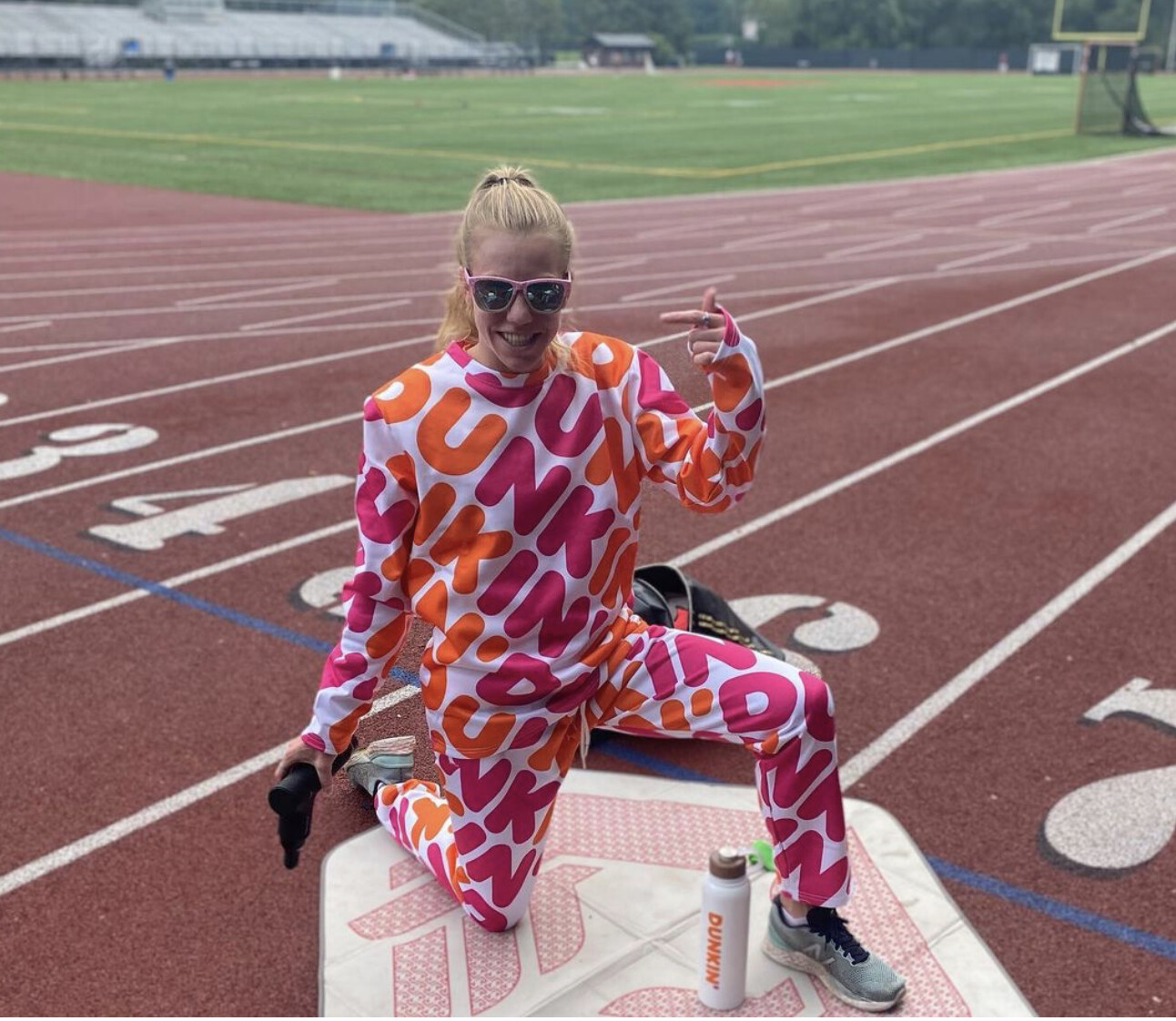
Boling went viral in 2019 when he broke the 10-second barrier for 100m with a wind-aided 9.97 seconds. pular U.S. doughnut chain DunkiMost athletes would only dream of what comes with a coffee and doughnut sponsorship. U.S. 1,500m Olympian Heather MacLean was disgruntled by Dunkin’s decision not to choose her, expressing her displeasure on Twitter.n’ Donuts has signed Georgia sprinter Matthew Boling, as the captain of Team Dunkin’, marking the brand’s first connection to an NCAA athlete.The popular U.S. doughnut chain Dunkin’
She even already has the tracksuit.
Dunkin’ Donuts is headquartered in Canton, Mass. It was founded in 1950Although MacLean is no longer in college, her Dunkin’ tracksuit has hopefully made a strong case for a potential sponsorship in the future. U.S. marathoner Molly Seidel also has a soft spot for Dunkin’. While she was living and training in Boston, Dunkin’ became her donut shop of choice, and she also spoke about her interest in a Dunkin’ sponsorship.Boling will be representing Dunkin’ on and off the track, sharing his exclusive Team Dunkin’ experience and merchandise on social media. Each Team Dunkin’ athlete will be honoured by having their very own Dunkin’ drinks and food featured at a Dunkin’ location in their college town.Donuts has signed Georgia sprinter Matthew Boling, as the captain of Team Dunkin’, marking the brand’s first connection to an NCAA athlete.
by Running magazine
Login to leave a comment
You Know You Have to Get Comfortable With the Uncomfortable on Tough Runs—Here's How
All runners can benefit from learning these simple thought techniques.
Olympic medalist and champion marathoner Meb Keflezighi thought about dropping out of every marathon he ran—even the three he won.
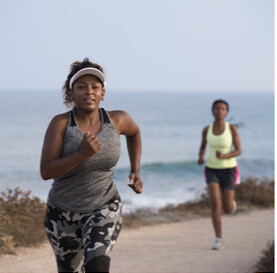
So if you’ve had those thoughts, it’s certainly not just you. All runners have rough patches when pushing themselves, whether in a race, during a hard workout, or on a long run. Experts use the phrase “psychological crisis” to describe when your body’s signals dominate your attention and you think about slowing or stopping.
These moments often occur two-thirds to three-quarters of the way through a workout or race. Speaking about the Ursuline Academy runners she coaches in Dallas, elite runner Becky Wade says: “They’re deep enough into the race that they’re hurting, but not close enough to the finish line yet to get excited or start kicking. It’s easy to doubt whether they’ll be able to hang on, and they back off a bit as a protective mechanism.”
What separates Keflezighi, Wade, and other successful runners from some of us is that they know these rough patches will come, and they have mental strength techniques for dealing with them.
These techniques are quite simple. Even better, they can be learned, and then honed, so that you persevere despite the internal voice telling you to back off or drop out. Here are six elite-endorsed ways to build mental strength when the going gets tough.
1. Know Why You’re Doing This
Good goals not only guide your training. They can also fortify you during difficult stretches.
Know the purpose of a given workout or race, and how it will help you meet a personally meaningful goal, says Olympian Roisin McGettigan, a sport psychology coach who holds the Irish record in the steeplechase.
For example, “if it was a long workout, I would remind myself that this is the time to work on my strength and endurance,” McGettigan says. “If it was an early-season race, the purpose might be ‘to see where I’m at’ or ‘blow off the cobwebs.’”
These why-am-I-doing-this thoughts can occur not just when you’re acutely suffering, but also when you’re bored or apathetic. McGettigan says to remind yourself why you’re out there in those situations as well. Think of how easy running will help you recover for your next key workout, or how an hour alone on the roads provides a calming antidote to the message-a-minute pace of modern life.
If thoughts alone don’t do the job for you, McGettigan recommends using visual cues. “I often drew a smiley face or heart on my hand to remind me that I really loved what I was doing and I was saying ‘yes’ to this experience,” she says.
2. Enlist Family and Friends
Telling a few key people about your race or hard workout adds accountability. When a moment of crisis occurs, picture yourself recounting the run to them. Will you be proud to tell them how you handled the challenge?
Keflezighi was in 21st place halfway through the 2012 Olympic Marathon. Bothered by stomach and foot pain, he pondered dropping out. Then he thought about his family, who were waiting for him at the finish line. What kind of example would dropping out set for his daughters, he asked himself. He committed to finishing no matter what, and wound up crossing the line in fourth place.
You can also enlist others in practical terms. As McGettigan notes, most elite runners train with others, in part to be pulled through hard efforts when they’re struggling and might otherwise slack off. Wade tells the high schoolers she coaches to latch on to a teammate or competitor if their resolve falters during a race. Doing so can shift your attention from how much you’re hurting to the more straightforward task of maintaining contact.
3. Visualize Success
To reiterate: Successful racers know one or more psychological crises are likely to occur when they’re pushing themselves. One way they prepare for the challenge is to play the race through their head before they get to the starting line. As Wade, a 2:30 marathoner, puts it, “I envision myself in a race atmosphere, down to the course, competition, and atmosphere.”
A key benefit of doing so is that, when the urge to slow or stop strikes, you have a counter-narrative ready—that vision you implanted and watched several times of yourself rising to the challenge and continuing to run strong.
“I think having visualized the race going well in my head many times allowed me to stay engaged, because I had already told myself I was going to have a good race,” says Mark Coogan, whose long elite career was highlighted by a spot on the 1996 Olympic marathon team. “Knowing what I was going to do in the race allowed me to be more aware of how I was running physically, so I could stay loose and smooth.”
Coogan is now the coach of New Balance Boston, which includes on its roster Olympians Elle Purrier St. Pierre and Heather MacLean. He encourages his athletes to spend 10 to 15 minutes a day visualizing in the week leading up to a big race.
“I tell them to visualize seeing themselves running well,” Coogan says. “Visualize the race you want to happen.”
4. Focus on Your Body—But Not Excessively
Experts used to believe that experienced runners focus on bodily sensations (known as associating) and that less experienced runners focus on anything but their body (known as dissociating). Thanks in part to research by Noel Brick, Ph.D., a psychology professor at the University of Ulster and co-author of The Genius of Athletes, it’s now known that that old dichotomy is too simplistic.
Brick has shown that a Goldilocks-level of bodily awareness leads to lower perceived exertion. “Focusing excessively on bodily sensations, like breathing or feelings of discomfort, can be harmful to our performance,” Brick says. Focusing solely on these sensations can negatively affect performance by increasing how hard the work feels and making the run feel more unpleasant. This then leads to slowing down.
A better approach? Check in periodically, notice what your body is telling you, and then focus elsewhere. When racing a 10K, for example, Coogan would do a body check about once a mile. He’d make sure his shoulders were low and level, that his hands were cupped loosely, that he wasn’t overstriding, and so on. Now as a coach, he periodically yells “body check” to his runners to remind them to do a quick scan.
Consider running form cues when doing your own body scan, making sure you’re running relaxed but strong—after you make adjustments, take your thoughts elsewhere.
5. Chunk Your Miles
If, a few strides into a marathon you think, “Oof, 26.2 miles to go,” you likely have a long day ahead of you.
Successful runners avoid getting overwhelmed by what they’re attempting with a technique known as chunking. “I mentally break the effort down into manageable bites, and focus only on getting through the bit I’m in,” Wade says. “This often means completing a loop, making it to my water bottle, or getting through a specific stretch of road or distance.” Or, as U.S. half marathon record-holder Ryan Hall put it in his book title, run the mile you’re in.
Notice that Wade’s examples of chunking are specific tasks. Psychologists call these process goals—step-by-step actions that contribute to performing well in the short term. Focusing on process goals has two key payoffs. First, they keep you from overthinking the run’s outcome, such as what your time will be. Research has shown that thinking too much about outcome goals can induce anxiety and cause distraction.
Chunking via process goals also encourages actions that directly improve your performance. One of Coogan’s main focuses when marathoning was making sure he got his bottle every 5K, and then taking the time to drink adequately from the bottle. Doing so ensured that he stayed hydrated and fueled, and therefore didn’t falter in the final miles. Similarly, Wade’s focus on the next stretch of a road race, or her next split in a track race, leads to running that section of the race as well as possible.
Chunking is also helpful during interval workouts. Wade encourages the high schoolers she coaches to focus on just the current repeat or set, and reminds them that a recovery jog and chance to regroup is never more than a few minutes away.
6. Talk to Yourself Like You’re Your Coach
We all talk to ourselves when we run. (If you doubt that, monitor your mind on your next outing.) What matters here is the nature of that talk.
A study published in Psychophysiology found that people rated running at a given speed harder when they talked to themselves negatively compared to when their self-talk was positive. The runners also produced more cortisol, a hormone associated with emotional stress, when their self-talk was negative.
During a tough patch, Brick advises, “you might say to yourself, ‘my legs feel tired, but I can push through this.’ Research has shown that using simple statements like this can help us maintain our performance, despite how tired we feel.”
Coogan would repeat a few go-to phrases to himself, such as “you’re okay, Mark,” during races and hard workouts. And research supports Coogan’s tendency to speak to himself in the second person—using “you” rather than “I.”
In a study with cyclists, the participants did separate 10K time trials in which they used two versions of positive self-talk phrases. The phrases were identical except that in one they addressed themselves as “I,” and in the other they addressed themselves as “you.” Although the cyclists rated the time trials as feeling equally hard, when they spoke to themselves in the second person, they rode 2.2 percent faster. If that seems like an insignificant difference, consider that a 24:30 5K is 2 percent faster than a 25:00 5K. Which would you rather run?
Psychologists say this distinction works because addressing yourself as “you” provides emotional distance from the duress you’re under. In this set-up, you’re talking to yourself more like a coach would talk to you. And a good coach would never say, “you stink—drop out.” They would find a simple phrase or two that would help you weather the crisis and push through for a strong finish. With this simple switch in your thinking, you can provide that mental push for yourself.
by Runner’s World
Login to leave a comment
Olympic medalist and champion marathoner Meb Keflezighi thought about dropping out of every marathon he ran—even the three he won.
So if you’ve had those thoughts, it’s certainly not just you. All runners have rough patches when pushing themselves, whether in a race, during a hard workout, or on a long run. Experts use the phrase “psychological crisis” to describe when your body’s signals dominate your attention and you think about slowing or stopping.
These moments often occur two-thirds to three-quarters of the way through a workout or race. Speaking about the Ursuline Academy runners she coaches in Dallas, elite runner Becky Wade says:

“They’re deep enough into the race that they’re hurting, but not close enough to the finish line yet to get excited or start kicking. It’s easy to doubt whether they’ll be able to hang on, and they back off a bit as a protective mechanism.”
What separates Keflezighi, Wade, and other successful runners from some of us is that they know these rough patches will come, and they have mental strength techniques for dealing with them.
These techniques are quite simple. Even better, they can be learned, and then honed, so that you persevere despite the internal voice telling you to back off or drop out. Here are six elite-endorsed ways to build mental strength when the going gets tough.
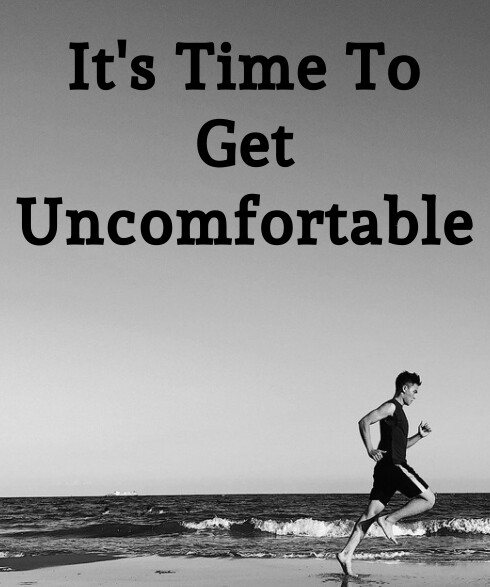
1. Know Why You’re Doing This
Good goals not only guide your training. They can also fortify you during difficult stretches.
Know the purpose of a given workout or race, and how it will help you meet a personally meaningful goal, says Olympian Roisin McGettigan, a sport psychology coach who holds the Irish record in the steeplechase.
For example, “if it was a long workout, I would remind myself that this is the time to work on my strength and endurance,” McGettigan says. “If it was an early-season race, the purpose might be ‘to see where I’m at’ or ‘blow off the cobwebs.’”
These why-am-I-doing-this thoughts can occur not just when you’re acutely suffering, but also when you’re bored or apathetic. McGettigan says to remind yourself why you’re out there in those situations as well. Think of how easy running will help you recover for your next key workout, or how an hour alone on the roads provides a calming antidote to the message-a-minute pace of modern life.
If thoughts alone don’t do the job for you, McGettigan recommends using visual cues. “I often drew a smiley face or heart on my hand to remind me that I really loved what I was doing and I was saying ‘yes’ to this experience,” she says.
2. Enlist Family and Friends
Telling a few key people about your race or hard workout adds accountability. When a moment of crisis occurs, picture yourself recounting the run to them. Will you be proud to tell them how you handled the challenge?
Meb Keflezighi was in 21st place halfway through the 2012 Olympic Marathon. Bothered by stomach and foot pain, he pondered dropping out. Then he thought about his family, who were waiting for him at the finish line. What kind of example would dropping out set for his daughters, he asked himself. He committed to finishing no matter what, and wound up crossing the line in fourth place.
You can also enlist others in practical terms. As McGettigan notes, most elite runners train with others, in part to be pulled through hard efforts when they’re struggling and might otherwise slack off. Wade tells the high schoolers she coaches to latch on to a teammate or competitor if their resolve falters during a race. Doing so can shift your attention from how much you’re hurting to the more straightforward task of maintaining contact.
3. Visualize Success
To reiterate: Successful racers know one or more psychological crises are likely to occur when they’re pushing themselves. One way they prepare for the challenge is to play the race through their head before they get to the starting line. As Wade, a 2:30 marathoner, puts it, “I envision myself in a race atmosphere, down to the course, competition, and atmosphere.”
A key benefit of doing so is that, when the urge to slow or stop strikes, you have a counter-narrative ready—that vision you implanted and watched several times of yourself rising to the challenge and continuing to run strong.
“I think having visualized the race going well in my head many times allowed me to stay engaged, because I had already told myself I was going to have a good race,” says Mark Coogan, whose long elite career was highlighted by a spot on the 1996 Olympic marathon team. “Knowing what I was going to do in the race allowed me to be more aware of how I was running physically, so I could stay loose and smooth.”
Coogan is now the coach of New Balance Boston, which includes on its roster Olympians Elle Purrier St. Pierre and Heather MacLean. He encourages his athletes to spend 10 to 15 minutes a day visualizing in the week leading up to a big race.
“I tell them to visualize seeing themselves running well,” Coogan says. “Visualize the race you want to happen.”
4. Focus on Your Body—But Not Excessively
Experts used to believe that experienced runners focus on bodily sensations (known as associating) and that less experienced runners focus on anything but their body (known as dissociating). Thanks in part to research by Noel Brick, Ph.D., a psychology professor at the University of Ulster and co-author of The Genius of Athletes, it’s now known that that old dichotomy is too simplistic.
Brick has shown that a Goldilocks-level of bodily awareness leads to lower perceived exertion. “Focusing excessively on bodily sensations, like breathing or feelings of discomfort, can be harmful to our performance,” Brick says.
Focusing solely on these sensations can negatively affect performance by increasing how hard the work feels and making the run feel more unpleasant. This then leads to slowing down.
by Runner’s World
Login to leave a comment
Klosterhalfen and Purrier St Pierre lead Millrose mile field
The past two winners of the women's Millrose Games Wanamaker Mile – Elle Purrier St Pierre and Konstanze Klosterhalfen – will race for further success when the World Athletics Indoor Tour Gold meeting returns in New York on 29 January.
World 5000m bronze medallist Klosterhalfen is the 2019 Wanamaker Mile champion and the multiple German record-holder went on to chase Purrier St Pierre all the way to the line in the 2020 race, setting her personal best of 4:17.26. Last year she placed eighth in the Olympic 10,000m final, going close to her national record with 31:01.97.
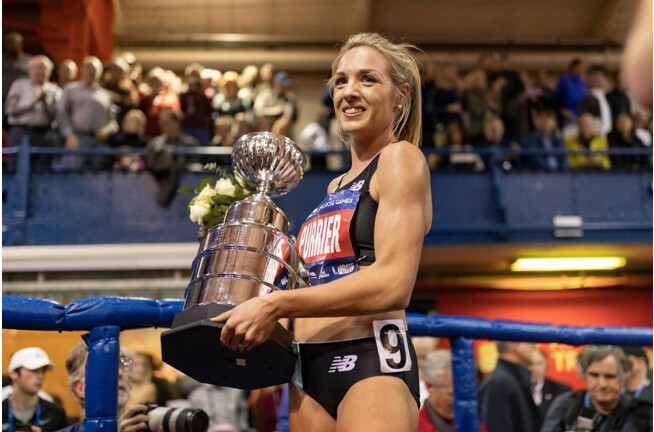
Purrier St Pierre, meanwhile, set her US indoor mile record of 4:16.85 at that 2020 Millrose Games meeting, a time which places her second on the world indoor all-time list. Since that breakout performance, she has set a North American indoor record of 9:10.28 for two miles, taking her to third on the world indoor all-time list, and then won at the US Trials in a meeting record of 3:58.05. She went on to place 10th in a high-quality Olympic final in Tokyo.
"I am really looking forward to racing the Wanamaker Mile this year," Purrier St Pierre said.
"This race has always been a special one for me and I certainly missed it last year. It's one of the most prestigious and historic races, it's always fun and always competitive, just the way I like it."
Joining them in the WHOOP Women’s Wanamaker Mile field are two other athletes who represented the USA in the Tokyo Olympic Games 1500m.
Cory McGee and Heather MacLean placed second and third respectively in last year’s Olympic Trials behind Purrier St Pierre, with McGee going on to finish 12th in the Olympic final and MacLean reaching the semifinals.
Josette Norris also joins the mix after a season in which she broke four minutes in the 1500m and placed third in the Zurich Wanda Diamond League final.
Other major threats will be Jessica Hull, the Australian record-holder and four-time NCAA champion, along with world finalist Nikki Hiltz, British Olympian Katie Snowden and Spanish Olympian Esther Guerrero.
Rounding out the field is Olympic Trials fourth-place finisher Shannon Osika and both the 2021 NCAA mile and 1500m champions in Sage Hurta and Anna Camp Bennett, respectively.
Other athletes so far announced for the Millrose Games include world 100m hurdles record-holder Kendra Harrison, 2016 world indoor 60m champion Trayvon Bromell, Olympic shot put champion Ryan Crouser, world shot put champion Joe Kovacs, Olympic 800m champion Athing Mu, Olympic pole vault champion Katie Nageotte and world indoor pole vault champion Sandi Morris.
by World Athletics
Login to leave a comment
The Weird and Wonderful Moments From the Olympic Trials That You May Have Missed
Want to run fast? Try wearing a pair of Doritos earrings, just like Christina Clemons.
During the 2021 Olympic Track and Field Trials, held at Hayward Field in Eugene, Oregon, we watched as the nation’s best athletes competed for spots to race at the Tokyo Games—the pinnacle for these runners. But we also some wacky, weird, and wonderful moments, reminding us that no matter how fast these athletes can run, they’re still human.
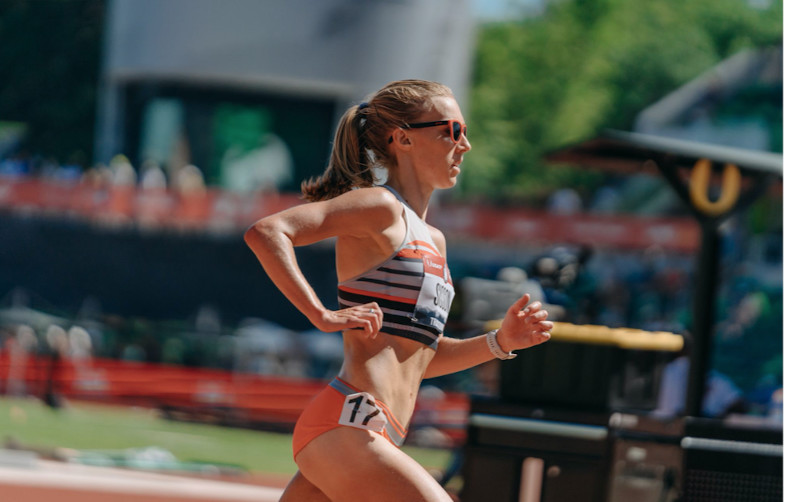
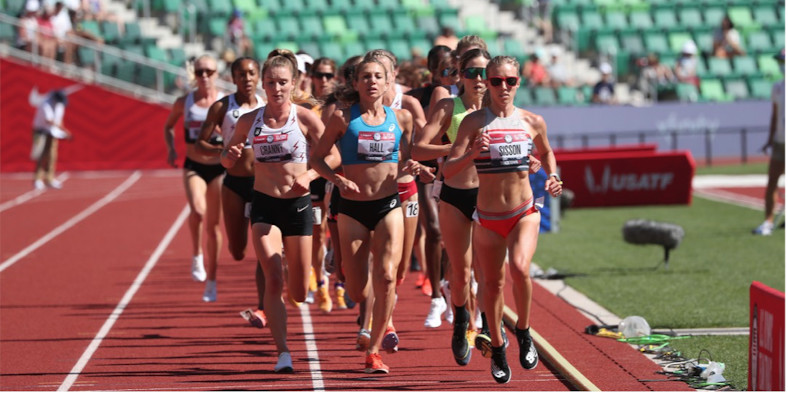
Lewis Johnson goes for a dip in the steeplechase water pit
Before the first round of the women’s 3000-meter steeplechase on Sunday, June 20, NBC broadcaster Lewis Johnson was tasked with explaining exactly what the steeplechase race is. (Runners jump over 35 barriers, seven of which are over a water pit. It also started as a horse race. Read more here!) Not only did he show viewers on TV all around the barriers, he actually took his shoes and socks off and waded into the water pit to show how deep it was. Talk about dedication to his craft.
A short time later, Allyson Felix qualified for her fifth Olympic team, finishing second in the 400 meters—and when Johnson was interviewing her trackside, his shorts appeared to be dry. Did he bring an extra pair of shorts and change? Was it so hot that his shorts dried? I haven’t stopped thinking about this for over a week. — Bette Canter
Christina Clemons makes the Olympic team wearing Doritos earrings
Forget the Wheaties cereal box. Christina Clemons, who made her first Olympic team in the 100-meter hurdles during the opening weekend of the Trials, has her face on a bag of Doritos!
How did this happen? According to The Washington Post, Clemons was looking for new earrings before the meet and purchased a pair of Cool Ranch Doritos bling at a Hot Topic. We’re so thankful that eagle-eyed viewers and on-site photographers spotted the awesome earrings, helping the selection go viral and providing Clemons this unique opportunity. May I suggest for her Olympic run, she get mini earrings of her favorite high-end car? — Brian Dalek
New England Pride in the Women’s 1500
I’m not a “real” New Englander—I’ve lived in Maine for only 18 years, or about 200 years shy of many natives’ standards for sufficient family roots. But from the fan boy angle, close enough. So it was a treat to see Vermonter Elle Purrier St. Pierre and Heather MacLean of Massachusetts finish first and third, respectively, in the women’s 1500 final amid the usual west-of-the-Mississippi-based candidates.
The moment was made sweeter by MacLean nabbing the Olympic standard, her and Purrier St. Pierre’s modest college running achievements, and the fact that they’re New Balance Boston teammates and close friends. Or, as their coach, Mark Coogan, told Runner’s World in his best southern Massachusetts intonation, “A girl from UMass and a girl from UNH are going to the Olympics, in the mile. Top that!” — Scott Douglas
Michelle Obama congratulates Sha’Carri Richardson
After Sha’Carri Richardson dominated the women’s 100-meter final with a winning time of 10.86, her performance and reaction afterwards (she ran into the stands to hug her grandmother right after the victory) went viral. Even former First Lady Michelle Obama took notice and tweeted a message congratulating the national champion. Obama tweeted a video clip of Richardson’s post-race interview in which the sprinter shared that her biological mother passed away before the championship. Richardson also thanked her family, especially her grandmother who witnessed Richardson become an Olympian.
“Without my grandmother, there would be no Sha’Carri Richardson,” Richardson told Lewis Johnson on NBC. “My family is my everything, my everything until the day I’m done.”
Richardson responded to the Becoming author’s tweet with a message of her own.
“I am up right now losing my mind!” Richardson wrote at 2:41 a.m. PDT on June 23. — Taylor Dutch
Even the pros sometimes borrow gear from their significant other
She’d sketched out her race plan lap by lap and even traded out her pre-race coffee for caffeinated gum to stay cooler. But there was one minor detail Emily Sisson realized she forgot as she was stepping onto the track to dominate the women’s 10,000 meters Saturday morning: shades. Fortunately, her husband, Shane Quinn, had a pair he was willing to part with.
“I stole them off him as we were walking into the warm-up area,” she said post-race. Those red-and-black frames—which appeared to be from goodr—made her look even more like a boss as she lapped nearly everyone en route to a new meet record and her first Olympic spot. — Cindy Kuzma
Runners warming up ... around a cemetery
Eugene Pioneer Cemetery, on the National Register of Historic Places, is also a destination for U.S. elite distance runners, warming up and cooling down for the races in Hayward Field.
The cemetery, which has a dirt trail around its perimeter that’s roughly 0.6 miles long, saw plenty of use during the Olympic Trials. Before the semifinal round of the women’s 1500, Runner’s World spotted Jenny Simpson, Dani Jones, Amanda Eccleston, Sarah Lancaster and others jogging the loop before heading one block east to the athlete entrance to the track. After the semis of the men’s 800, Bryce Hoppel went over for a cooldown.
The cemetery isn’t affiliated with the University of Oregon, but it’s adjacent to the campus, and many Duck track athletes over the years have used it for their runs. It’s an easy target for, well, gallows humor—as athletes hope warming up their doesn’t signal the death knell of their careers.
by Runner’s World
Login to leave a comment
130 athletes named on the team to represent the United States at the Tokyo Olympic Games
World outdoor record-holders Sydney McLaughlin, Ryan Crouser and Keni Harrison are among the 130 athletes named on the team to represent the United States at the Tokyo Olympic Games.
The squad includes 13 medalists from the 2016 Games in Rio and six defending world champions from Doha. Experienced headliners include five-time Olympians Allyson Felix in the 400m and Abdi Abdirahman in the marathon, while the youngest athlete on the team is 17-year-old Erriyon Knighton, who twice broke the world U20 200m record last month at the US Olympic Trials.
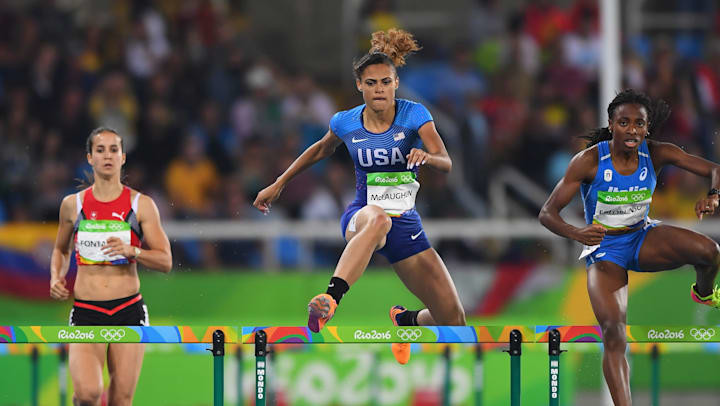
JuVaughn Harrison won both the long jump and high jump at the Trials in Eugene and he will be among the athletes contesting two events in Tokyo as he has been selected for both disciplines.
Other athletes announced on the team include world indoor 60m hurdles record-holder Grant Holloway, who was just 0.01 shy of breaking Aries Merritt’s world 110m hurdles record of 12.80 in Eugene, plus former world 400m hurdles record-holder Dalilah Muhammad, the second-fastest ever 200m sprinter Gabby Thomas and multiple global long jump gold medalist Brittney Reese.
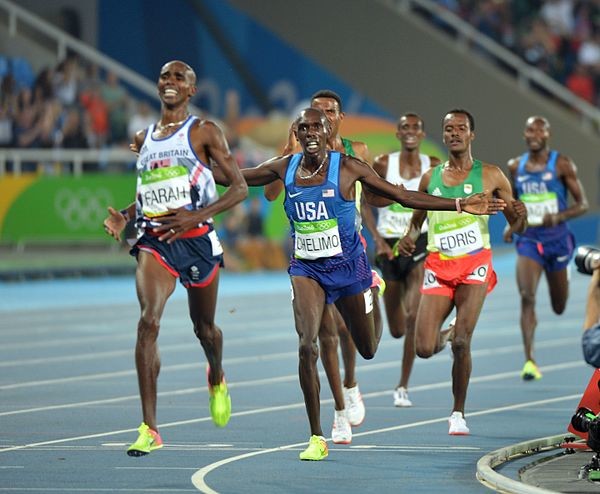
USA team for Tokyo
WOMEN
100m: Teahna Daniels, Javianne Oliver, Jenna Prandini
200m: Anavia Battle, Jenna Prandini, Gabby Thomas
400m: Allyson Felix, Quanera Hayes, Wadeline Jonathas
800m: Athing Mu, Raevyn Rogers, Ajee' Wilson
1500m: Heather MacLean, Cory McGee, Elle Purrier
5000m: Elise Cranny, Rachel Schneider, Karissa Schweizer
10,000m: Alicia Monson, Karissa Schweizer, Emily Sisson
Marathon: Sally Kipyego, Molly Seidel, Aliphine Tuliamuk
3000m steeplechase: Emma Coburn, Val Constien, Courtney Frerichs
100m hurdles: Christina Clemons, Gabbi Cunningham, Keni Harrison
400m hurdles: Anna Cockrell, Sydney McLaughlin, Dalilah Muhammad
20km race walk: Robyn Stevens
High jump: Tynita Butts-Townsend, Vashti Cunningham, Rachel McCoy
Pole vault: Morgann LeLeux, Katie Nageotte, Sandi Morris
Long jump: Quanesha Burks, Tara Davis, Brittney Reese
Triple jump: Tori Franklin, Jasmine Moore, Keturah Orji
Shot put: Adelaide Aquilla, Jessica Ramsey, Raven Saunders
Discus: Valarie Allman, Kelsey Card, Rachel Dincoff
Hammer: Brooke Andersen, Gwen Berry, DeAnna Price
Javelin: Ariana Ince, Maggie Malone, Kara Winger
Heptathlon: Erica Bougard, Annie Kunz, Kendell Williams
4x100m: English Gardner, Aleia Hobbs, Gabby Thomas (plus others selected in individual events)
4x400m: Kendall Ellis, Lynna Irby, Kaylin Whitney (plus others selected in individual events)
MEN
100m: Ronnie Baker, Trayvon Bromell, Fred Kerley
200m: Kenny Bednarek, Erriyon Knighton, Noah Lyles
400m: Michael Cherry, Michael Norman, Randolph Ross
800m: Bryce Hoppel, Isaiah Jewett, Clayton Murphy
1500m: Matthew Centrowitz, Cole Hocker, Yared Nuguse
5000m: Paul Chelimo, Grant Fisher, Woody Kincaid
10,000m: Grant Fisher, Woody Kincaid, Joe Klecker
Marathon: Abdi Abdirahman, Jake Riley, Galen Rupp
3000m steeplechase: Hillary Bor, Mason Ferlic, Benard Keter
110m hurdles: Devon Allen, Grant Holloway, Daniel Roberts
400m hurdles: Rai Benjamin, David Kendziera, Kenny Selmon
20km race walk: Nick Christie
High jump: JuVaughn Harrison, Shelby McEwen, Darryl Sullivan
Pole vault: Sam Kendricks, KC Lightfoot, Chris Nilsen
Long jump: Marquis Dendy, JuVaughn Harrison, Steffin McCarter
Triple jump: Chris Benard, Will Claye, Donald Scott
Shot put: Ryan Crouser, Joe Kovacs, Payton Otterdahl
Discus: Mason Finley, Reggie Jagers, Sam Mattis
Hammer: Daniel Haugh, Rudy Winkler, Alex Young
Javelin: Michael Shuey, Curtis Thompson
Decathlon: Steven Bastien, Garrett Scantling, Zach Ziemek
4x100m: Kenny Bednarek, Cravon Gillespie, Micah Williams (plus others selected in individual events)
4x400m: Elija Godwin, Vernon Norwood, Trevor Stewart (plus others selected in individual events)
MIXED
4x400m: Shae Anderson, Bryce Deadmon, Wil London, Taylor Manson (plus others selected in individual events).
by World Athletics
Login to leave a comment
Tokyo 2020 Olympic Games
Fifty-six years after having organized the Olympic Games, the Japanese capital will be hosting a Summer edition for the second time, originally scheduled from July 24 to August 9, 2020, the games were postponed due to coronavirus outbreak, the postponed Tokyo Olympics will be held from July 23 to August 8 in 2021, according to the International Olympic Committee decision. ...
more...Murphy, Purrier St Pierre and Nilsen among the winners on day of surprises in Eugene
With mayhem all around on the fourth day of action at the US Olympic Trials, two-time world pole vault champion Sam Kendricks is relieved to be going to Tokyo. Two other winners of global titles – world 800m champion Donavan Brazier and 2011 world 1500m champion Jenny Simpson – will not be heading to the Games.
“A gold medal brings golden handcuffs,” Kendricks said. “Wherever we go somewhere it’s a world champion, and they expect a world champion’s effort. People follow in your wake when you’re ahead of the game.”
Clayton Murphy stayed ahead on Monday night (21) in Eugene.
He ran an evenly split world lead of 1:43.17 to win the men’s 800m, showing the form he had as 21-year-old to earn Olympic bronze in Rio in 2016. It was an emphatic response to those who were unsure he would ever recapture that.
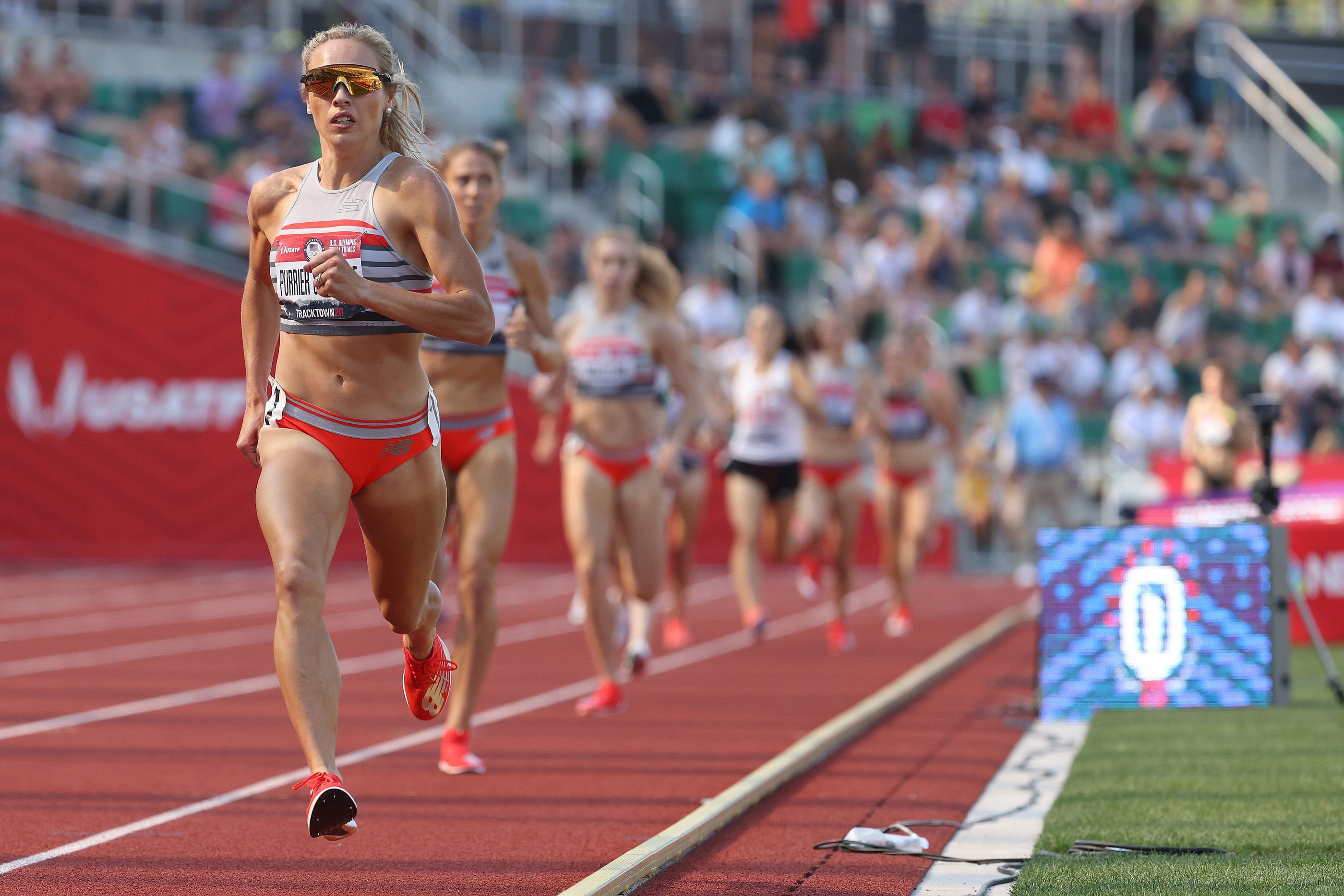
That 800m – plus a historic pole vault competition won by Chris Nilsen and a front-running 1500m by Elle Purrier St Pierre – were the highlights of day four ahead of two rest days.
Shockingly, Brazier faded to last in the 800m and will miss a second successive Olympics. He was a pre-trials favourite in 2016, at age 19, coming off a 1:43.55 and NCAA victory, but he failed to get out of the first round then.
This time, NCAA champion Isaiah Jewett bolted ahead and built a lead with an opening lap of 50.60. Brazier crossed the 400m in 51.00 and attempted to reduce that gap on the final backstretch.
“I think I made a move a little too early and paid the price for it in the last 200,” he said.
Murphy, fifth at the midpoint at 51.67, said afterwards that he executed a perfect plan. He caught and passed Jewett, covering the second lap in 51.50. He said he had a “pretty serious hamstring issue” a few days before the trials but overrode it with adrenaline. He also overrode pre-trials form charts leaving him out of the requisite top three.
“It is hard not to read the middle-distance preview,” he said. “I kind of just accept it. As long as I handle it the right way, it is only motivation.”
Jewett was second in a PB of 1:43.85 and Bryce Hoppel, fourth at the 2019 World Championships, finished third in 1:44.14. Brazier eased to the finish in 1:47.88.
USA is sending “a pretty damn good team” to Tokyo, Murphy asserted. Jewett and Hoppel now sit at fourth and seventh on the 2021 world list, respectively.
“I think this is the most special moment in our sport,” said Murphy. “It is the most pure way to pick a team. This is what all those workouts pay off.”
Murphy and Brazier are qualified to run in the 1500m, but both said they probably would not. Brazier did not elaborate but said he was not running at 100 percent.
Jewett said his night was not over. He had a 10-page paper due for a course at the University of Southern California because a teacher had not granted his request for an extension.
Nilsen, an 18-year-old at the 2016 trials, said his goal then was to have his photo taken with Kendricks. In 2021, his 5.90m vault was enough to beat Kendricks and KC Lightfoot, second and third at 5.85m.
Matt Ludwig and Jacob Wooten were fourth and fifth at 5.80m, making this the first national competition ever featuring five men over 5.80m and 11 over 5.70m. It was also the first US meet ever to have three over 5.85m.
“This’ll go down in history as the hardest team ever to make,” Kendricks said.
The team in the women’s 1500m was also hard to make. An early stumble startled Purrier St Pierre, who on the spot decided to push the pace and led all the way thereafter.
Her time of 3:58.03 broke a trials record of 3:58.92 that Mary Slaney held for 33 years. Cory McGee was second in 4:00.67 and Heather MacLean, Purrier St Pierre’s training partner, was third in 4:02.09 as the top three all ran PBs. Shannon Osika was less than a tenth behind in 4:02.18.
Purrier St Pierre grew up on a dairy farm in rural Vermont and runs on dirt roads with her dog. She was shaken by the bumping to start the race.
“I couldn’t believe I’d just been shoved off the track,” she said. “After that, I thought I’d just go for it.”
Simpson, 34, the 2016 Olympic bronze medallist, was aiming for a fourth Olympics but finished 10th in 4:07.76. Coincidentally, she was Purrier St Pierre’s roommate in Doha.
Simpson conceded it was “hard to believe” she had not made the team; she had been on every Olympic or World Championships team since 2007.
“The sport goes on without you,” she said. “You don’t make the Games, and the Games are fine and they go on without you.”
With temperatures soaring past 32C, Elise Cranny won the 5000m in 15:27.81. Karissa Schweizer was second in 15:28.11 and Rachel Schneider third in 15:29.56. Abbey Cooper, who met the Olympic standard by running 15:07.80 in the heats on Friday, was fourth in 15:31.05.
In the absence of the injured Christian Taylor, Will Claye took the triple jump with 17.21m (0.1m/s). Donald Scott was second at 17.18m and Chris Bernard third at 17.01m. “My sights have always been on the gold medal,” Claye said. "I want to win whether Christian is there or not. I feel for Christian. A year ago, I was going through the same thing.”
Curtis Thompson had the four longest throws of the competition and won the javelin with 82.78m.
Roy Jordan for World Athletics
by World Athletics
Login to leave a comment
Three American Records and 10 National Records Fall at the New Balance Indoor Grand Prix
Elle Purrier’s indoor two-mile American record was just one of many highlights in New York.
Many of the best track and field athletes in the world returned to competition—some for the first time in several months, due to the COVID-19 pandemic—at the New Balance Indoor Grand Prix on February 13. The event, typically held at the Reggie Lewis Center in Boston, was relocated to the Ocean Breeze Athletic Complex in Staten Island, New York, because the Boston venue is serving as a mass vaccination site.
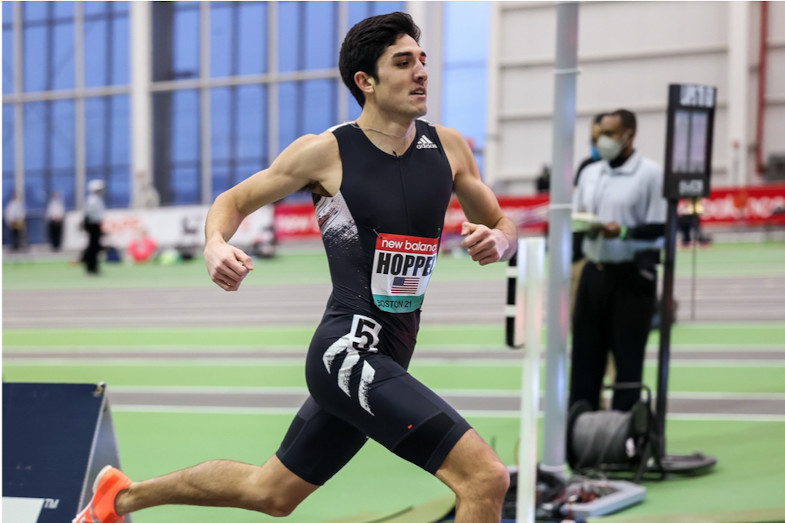
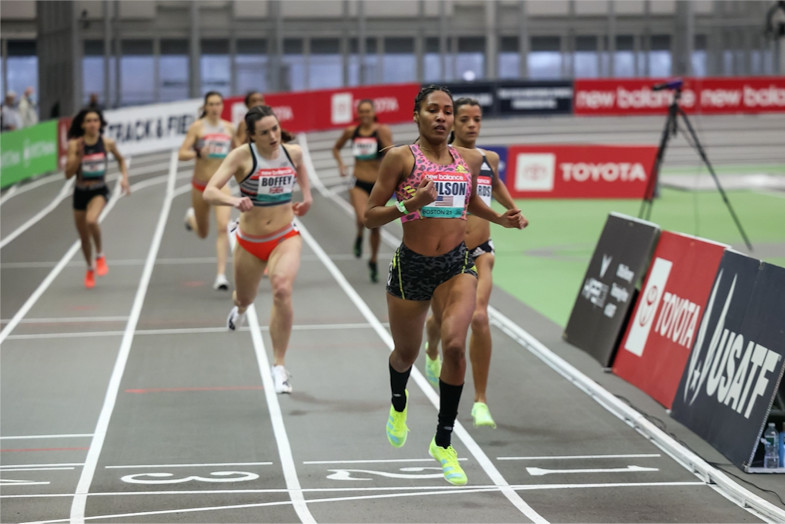
And the athletes made the most of this racing opportunity by breaking three American records and 10 national records total on Saturday.
Almost one year after shattering the American record in the mile at the Millrose Games, Elle Purrier broke another national record by winning the women’s two-mile in 9:10.28. Her time improves on the previous American record (9:18.35) set by Jenny Simpson in 2015. Purrier’s performance is also the third-fastest two-mile ever run in history. For Purrier, the victory follows a runner-up finish and 2:02.05 personal best in the 800 meters at the Prickly Pear Invitational in Phoenix, Arizona on February 6—her first race of 2021.
“I felt pretty confident going in, but you never know when you’re just training,” Purrier told journalists in a virtual mixed zone. “[Coach] Mark [Coogan] felt pretty confident about my fitness level, but after that [race] I’m feeling pretty good now.”
Looking back on her mile record a year ago, Purrier—who trains under Coogan with the New Balance group in Boston—said navigating the challenges of 2020 brought some silver linings to her process.
“Millrose was probably one of the biggest highlights of my career, and I think stopping after that was kind of a bummer because I felt like I was on a roll and the team was on a roll,” Purrier said in the mixed zone. “But we were able to kind of just wait it out this summer and get into some great training. And I went home and I find a lot of happiness there, and so I think that built this up to another great training block this fall and this winter.”
The 2018 NCAA mile champion followed the pacemaking set by Leah Falland, who brought the field through the first mile in 4:41. For the remaining laps, Purrier and steeplechase world champion Emma Coburn ran 1-2 in the front. With three laps to go, Purrier broke away from Coburn to seal the win and the record, running the final 400 meters in 63 seconds.
Five seconds behind Purrier, Coburn finished second in a personal best of 9:15.71. In the same race, Julie-Anne Staehli of Canada (9:22.66) and Amy-Eloise Markovc of Great Britain (9:30.69) broke national records for their respective countries.
Hoppel Sets a World Best for 2021
About 20 minutes later, Bryce Hoppel followed the momentum by running a world lead and U.S. national record in the 1,000 meters. The former Kansas Jayhawk and NCAA 800-meter champion broke the previous American record (2:16.76) set by the late David Torrence in 2014.
“It means everything,” Hoppel said. “It’s just something you dream of as a kid, and I couldn’t have done it without all the support that I have, my family, and my coach. They all make it possible. I mean, it feels awesome to get it. That was what I was going for.”
Behind Hoppel, Marco Arop of Canada finished second in 2:17.10, and Charlie Grice finished third in 2:17.20, a national record for Great Britain.
An American Record for Donovan Brazier
Two weeks after being forced to withdraw from the American Track League meet due to COVID-19 exposure, Donavan Brazier returned to the track with a vengeance.
The 2019 world champion lowered the American record by winning the men’s 800 meters in 1:44.21, more than two seconds ahead of runner-up Jamie Webb of Great Britain. Brazier set the previous American record (1:44.22) at the Millrose Games last year.
After Saturday’s victory, Brazier said his coach, Pete Julian, didn’t want him to hold back, and the strategy proved to be successful.
“Pete wanted me to go out and die. That was literally what he said, word-for-word,” Brazier said. “He said, ‘go out hard, see if you can hold it, and we’ll just gauge where you’re at from a fast pace.’ ... I don’t think I’m quite where I was at in Millrose last year, but I still think I’m in decent shape.”
Ajeé Wilson Returns to Competition
The women’s 800 meters featured an unexpected performance from a four-time world championship medalist and American record-holder.
Ajeé Wilson was a late entry to the meet after receiving treatment for a hamstring injury earlier in the week. Unlike her signature racing tactic of leading from the gun, Wilson ran behind the race-leader Kaela Edwards until the homestretch, where she sprinted ahead to finish first in 2:01.79.
“Not knowing exactly how things will play out with my body, I wasn’t trying to take any chances and felt a little more comfortable hanging behind,” Wilson said. “That’s something that we’ve been working on in practice. We’re maybe five strong in our group now, so that definitely prepared me for today and just being comfortable and also making sure I was still in a good position so when I wanted to move, I could.”
The performance is Wilson’s first race since winning the 800 meters at the 2020 USATF Indoor Championships on February 15, 2020. After Saturday’s race, Wilson said she didn’t feel comfortable traveling for competition last year amid the COVID-19 pandemic, as she interacts with people who are more at risk of catching the virus. Instead, she focused on training at her home base in Philadelphia. Her next competition will be the Texas Qualifier in Austin, Texas from February 26 to 27.
“Although things aren’t much better, I'm feeling a little more comfortable with the precautions we're all taking to be safe,” she said.
Behind Wilson, Sophia Gorriaran—a 15-year-old high school sophomore from Rhode Island—finished fifth in 2:03.94. One week earlier, Gorriaran notched the standard to compete at the 2021 U.S. Olympic Team Trials by running 2:02.44 against a professional field at the American Track League meet in Fayetteville, Arkansas.
Two National Records in the Men’s 1500
The men’s 1500 meters featured two national records. Oliver Hoare—who trains under coach Dathan Ritzenhein with the On Running pro group in Boulder, Colorado—kicked to victory in 3:32.35, a national record for Australia. Jake Wightman of Great Britain finished second in 3:34.48, and Sam Tanner—a sophomore at the University of Washington—finished third in 3:34.72, breaking the national record for New Zealand.
The women’s 1500 meters was won by Heather MacLean who out-paced Cory McGee in the final lap to win in 4:06.32.
Michael Norman Races the 400 Meters for the First Time in a Year
For the first time since the 2019 World Championships in Doha, Qatar, track fans got to see Michael Norman compete in his signature event, the 400 meters.
The former USC Trojan and NCAA champion—who broke the world record in the indoor 400 meters (44.52) at the NCAA championships in 2018—battled with his training partner Rai Benjamin down the homestretch to secure the victory in 45.34. Benjamin finished second in 45.39.
“The instinct just kicked in,” Norman said. “We're very competitive at practice, especially when it comes to competition. So having that little fun practice rivalry going on, I couldn't have Rai beat me in the race, but he's an amazing competitor, so it was a lot of fun.”
In 2019, Norman failed to make the world championship final in Doha after suffering from an injury in the semifinals. He raced once in 2020—9.86 in the 100 meters at a COVID-adjusted meet in Fort Worth, Texas last July. After a long hiatus from competition, Norman said he felt pleased with the effort on Saturday.
“I’m feeling good,” Norman said. “There's a lot of work that needs to be done, but the main purpose of today was just to go out and compete, have fun and to kind of knock the cobwebs off because it's been over a year since I’ve run that distance.”
Another National Record for Shaunae Miller-Uibo
In her second meet of the year, Shaunae Miller-Uibo broke another Bahamian national record by running 50.21 to win the women’s 400 meters. The time makes her the eighth-fastest performer all-time indoors. The 2016 Olympic champion achieved the mark two weeks after breaking the national record in the indoor 200 meters at the American Track League meet, where she ran a personal best of 22.40.
World record-holder Keni Harrison also ran a world leading time on Saturday. The 2018 world indoor champion won the 60-meter hurdles in 7.82 seconds.
In the same race, Sydney McLaughlin finished last in 8.56. The race was McLaughlin’s highly anticipated return to the track after earning silver in the 400-meter hurdles and contributing to Team USA’s winning performance in the 4x400-meter relay at the 2019 World Championships. Saturday’s race was McLaughlin’s first time contesting the event since 2015, when she was in high school.
After the race, she said the race was an exercise in training with her non-dominant leg over hurdles. “It’s something we've been thinking about for awhile, just being able to hurdle efficiently with both legs, and what better way to do that than the short hurdles?” McLaughlin said. “It's such a short race and such a fast-paced race that you can really work on that technique. It was good to get into a fast race and really be forced to use it without being able to think that much.”
Noah Lyles Keeping His Eyes on Tokyo
Noah Lyles did double duty in the sprints on Saturday. The 2019 200-meter world champion ran the first round of the 60 meters in 6.76 seconds and returned to the track to contest the 200 meters. Holding off competitors Deon Lendore and Jaron Flournoy, Lyles made it to the finish line in 20.80, well off the typical winning times in his signature event.
While Lyles admitted he wasn’t pleased with the time (and his body language conveyed as such), he still took the experience as a lesson moving forward in his bid to represent Team USA and win more medals at the Tokyo Games this summer.
“We’ve been training for a lot of strength and endurance and it obviously paid off because I was able to come into the 60, warm up, and then I was able to shake off any type of fatigue I had from it,” Lyles said. “I still feel really good, even coming off of the 200, like I could run three more. So I actually feel strong, which is really what we were trying to get out of training, and coming here was to see how much speed we got in the tank. To be honest, it actually proved that what we’re doing is working.”
Trayvon Bromell Crosses First in the 60 Meters
After battling a series of injuries for the past few years, Trayvon Bromell returned to his winning ways on Saturday. After leading the 60-meter semifinal in 6.53, the 2016 world indoor champion won the final in 6.50 by breaking away from his competition in the second half of the race. Runner-up Demek Kemp followed in 6.65.
Looking back on the challenges of the past few years, Bromell credited his spirituality with his return to form and a newfound motivation.
“I'm here to run and make an impact on kids, adults who may have lost hope,” Bromell said. “I feel like my testimony of what I’ve been through gives people that, and it shows the sport in another light than just winning medals or running fast times. That’s all good, but what impact do you leave? I’m trying to be impactful, not impressive.”

by Runner’s World
Login to leave a comment
Katie Mackey, the only three-time winner in the race’s history, and Tripp Hurt, the reigning USA 1 Mile Road Champion, lead the fields for the 24th Aetna Falmouth Elite Mile
Katie Mackey, the only three-time winner in the race’s history, and Tripp Hurt, the reigning USA 1 Mile Road Champion, lead the fields for the 24th Aetna Falmouth Elite Mile on August 17, organizers announced today. The mile is part of the Falmouth Track Festival, held the evening before the New Balance Falmouth Road Race.
The Aetna Falmouth Elite Mile will begin at 5 p.m. on Saturday, August 17, on the James T. Kalperis Track at Falmouth High School. Total prize purse for the men’s and women’s fields is $15,000, not including possible time bonuses, with the winners each taking home $3,500.

Beginning with the SBLI Family Fun Run and followed by the Aetna Falmouth Elite Mile and the Tommy Cochary High School Mile, the track festival will be streamed live on the New Balance Falmouth Road Race Facebook page beginning at 4 p.m.
Mackey, 31, is the 2017 USA 1-Mile Road Champion, 2018 USATF Club Cross Country Champion, American record-holder in the 4x1500m relay, and was eighth at 3000 meters in the 2018 IAAF World Indoor Championships. Hurt, 26, was third at this year’s USATF Indoor Championships in the 2 Mile and is a two-time USATF Outdoor Championships steeplechase finalist.
Also among the headliners in the women’s race is Heather Kampf, a member of the same medal-winning relay team as Mackey and a four-time USA 1 Mile Road Champion. After three events, Kampf and Hurt lead the standings in the 2019 Bring Back the Mile Grand Prix Tour, on which the Aetna Falmouth Elite Mile is the fourth stop.

Challenging Mackey and Kampf will be Cory McGee, who was fourth in the 2015 Pan American Games at 1500 meters and won the Sir Walter Miler on August 2 in 4:27.87; Stephanie Garcia, a two-time member of Team USA at the IAAF World Championships in the 3000-meter steeplechase (2011, 2015); Allie Buchalski, 2018 NCAA 5000-meter runner-up; Jessica Harris, third at 1500 meters in the 2019 NCAA Championships; Lianne Farber, a three-time All-American at the University of North Carolina who runs for Team New Balance Boston; Eleanor Fulton, a two-time member of Team USA for the mixed relay at the IAAF World Cross Country Championships (2017, 2019); Vanessa Fraser, fourth in the 2018 NCAA 5000 meters; Dana Giordano, third at 1500 meters in 2016 NCAA Championships, who competes on the B.A.A. High Performance Team and has a family home in Woods Hole; and Heather MacLean, a Massachusetts state champion out of Peabody High School and an All-American while at UMass-Amherst who just finished seventh at USATF Outdoor Nationals in a personal best 4:05.27.
For the men, Tripp will face Josh Thompson, third at 1500 meters at the 2019 USATF Outdoor Championships; Garrett Heath, two-time USA 1 Mile Road Champion (2013, 2015); Pat Casey, the 2018 NACAC silver medalist at 1500 meters; Patrick Joseph, a member of Virginia Tech’s 2018 NCAA Indoor Champion Distance Medley team and fourth in the mile; Daniel Herrera, Mexico’s national record-holder in the mile; Riley Masters, 2018 USA 1 Mile Road Champion; David Ribich, two-time NCAA Division II 1500-meter champion (2017, 2018); Mason Ferlic, 2016 NCAA Champion in the 3000-meter steeplechase; Craig Nowak, a two-time All-American while at Oklahoma State; and Garrett O’Toole, the 2018 Ivy League indoor mile champion who now competes for Arizona State.
O’Toole, whose 4:01.89 mile while running for The Middlesex School was the fastest high school mile in the U.S. in 2014, won the Tommy Cochary High School Mile here in 2013, and still holds the meet record. At the Aetna Falmouth Elite Mile, O’Toole will be attempting to break the 4-minute barrier for the first time.
The Aetna Falmouth Elite Mile, which began in 1995, has played host to more than two dozen Olympians, including Morgan Uceny, Amy Rudolph, Carmen Douma-Hussar, Carrie Tollefson, Suzy Hamilton, Donn Cabral, Marc Davis, Robert Gary, Jason Pyrah, 2012 Olympic silver medalist Leo Manzano and two-time Olympic medalist Nick Willis of New Zealand. The event records are held by Hamilton (4:25.27, 2002) and Jordan McNamara (3:54.89, 2011).
Login to leave a comment
Falmouth Road Race
The Falmouth Road Race was established in 1973 and has become one of the premier running events of the summer season. Each year the race draws an international field of Olympians, elite runners and recreational runners out to enjoy the scenic 7-mile seaside course. The non-profit Falmouth Road Race organization is dedicated to promoting health and fitness for all in...
more...

